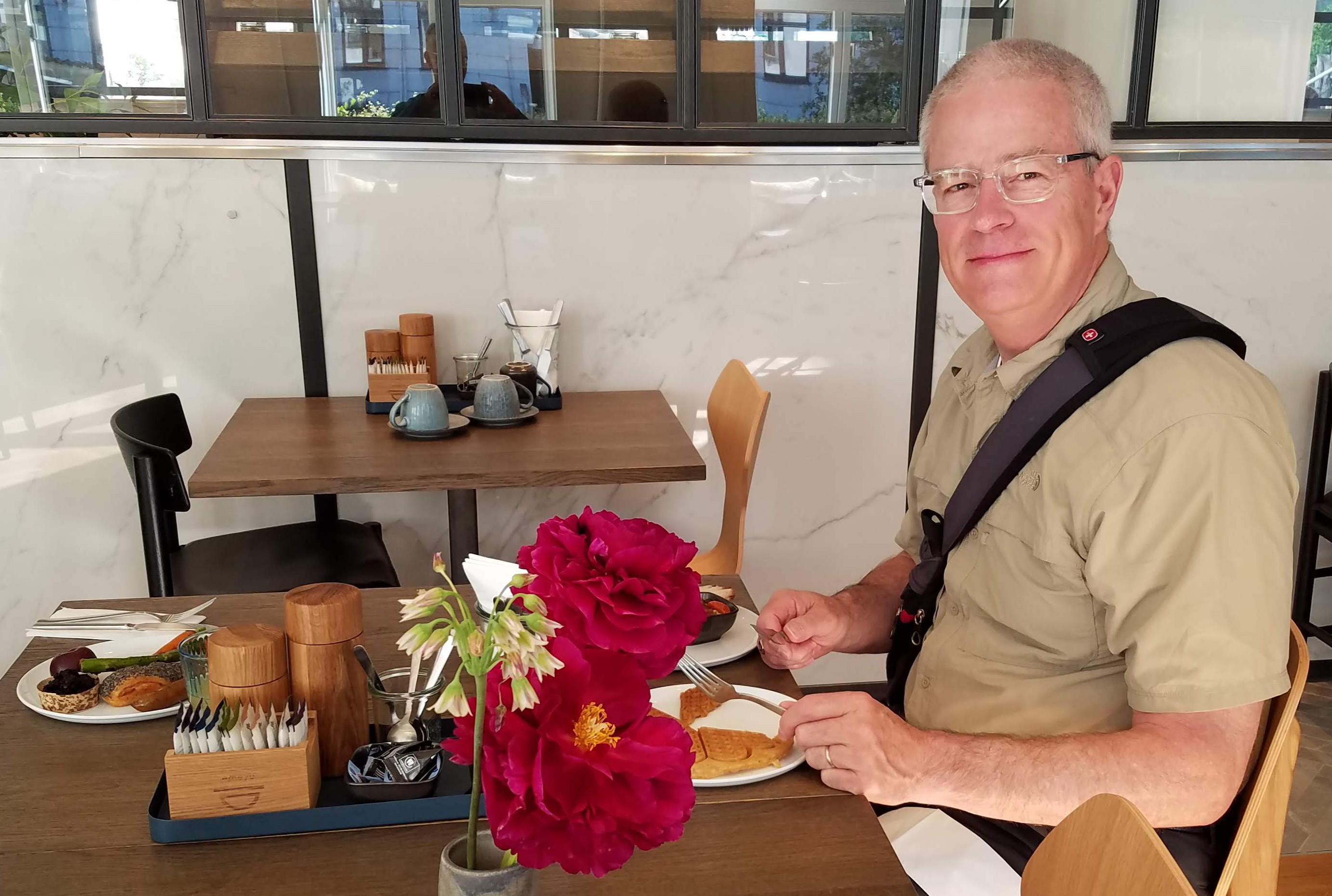
Breakfasting on sauteed vegetables, poppy seed pastries, and waffles
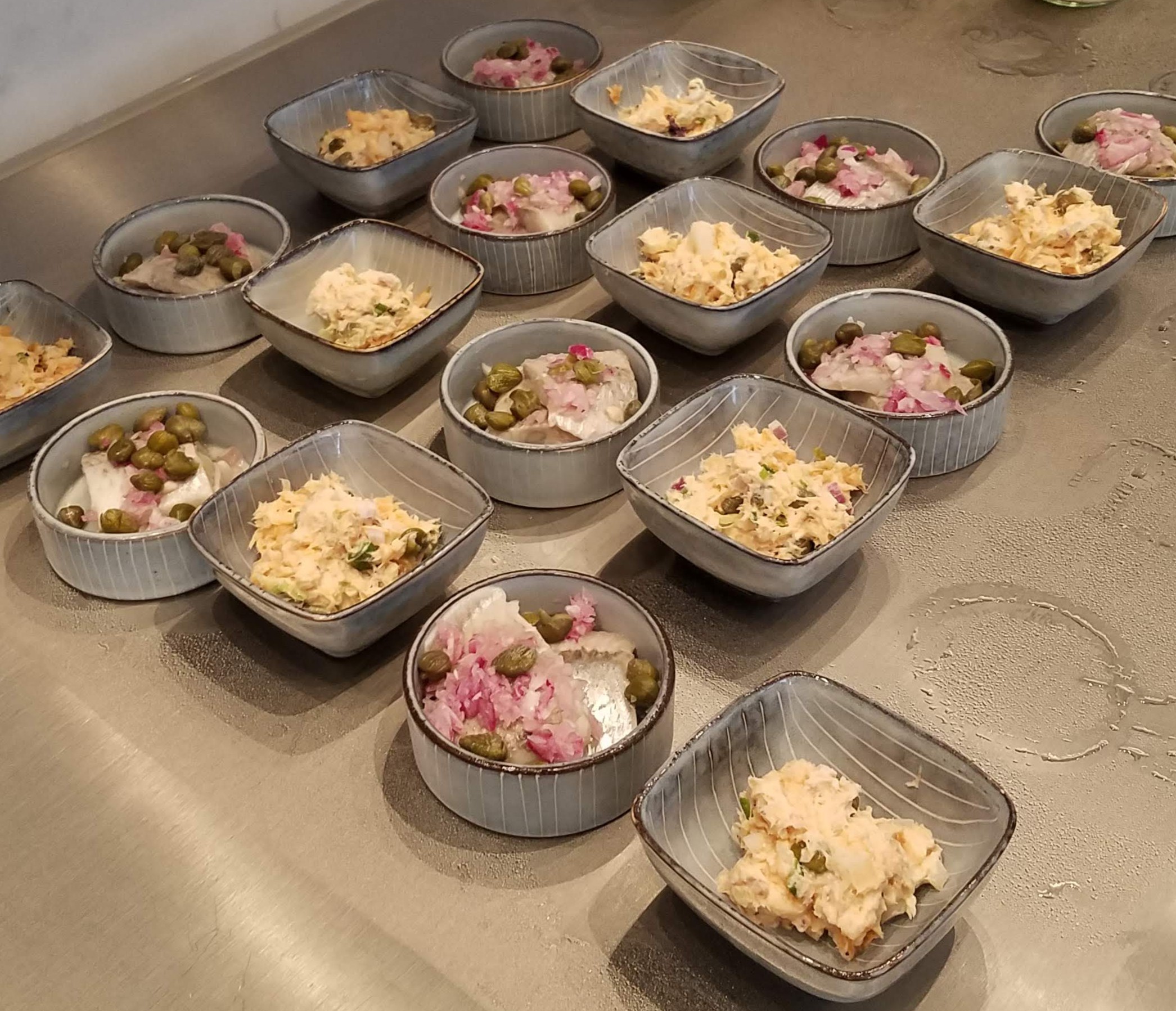
Assorted toppings for make-your-own smørrebrød
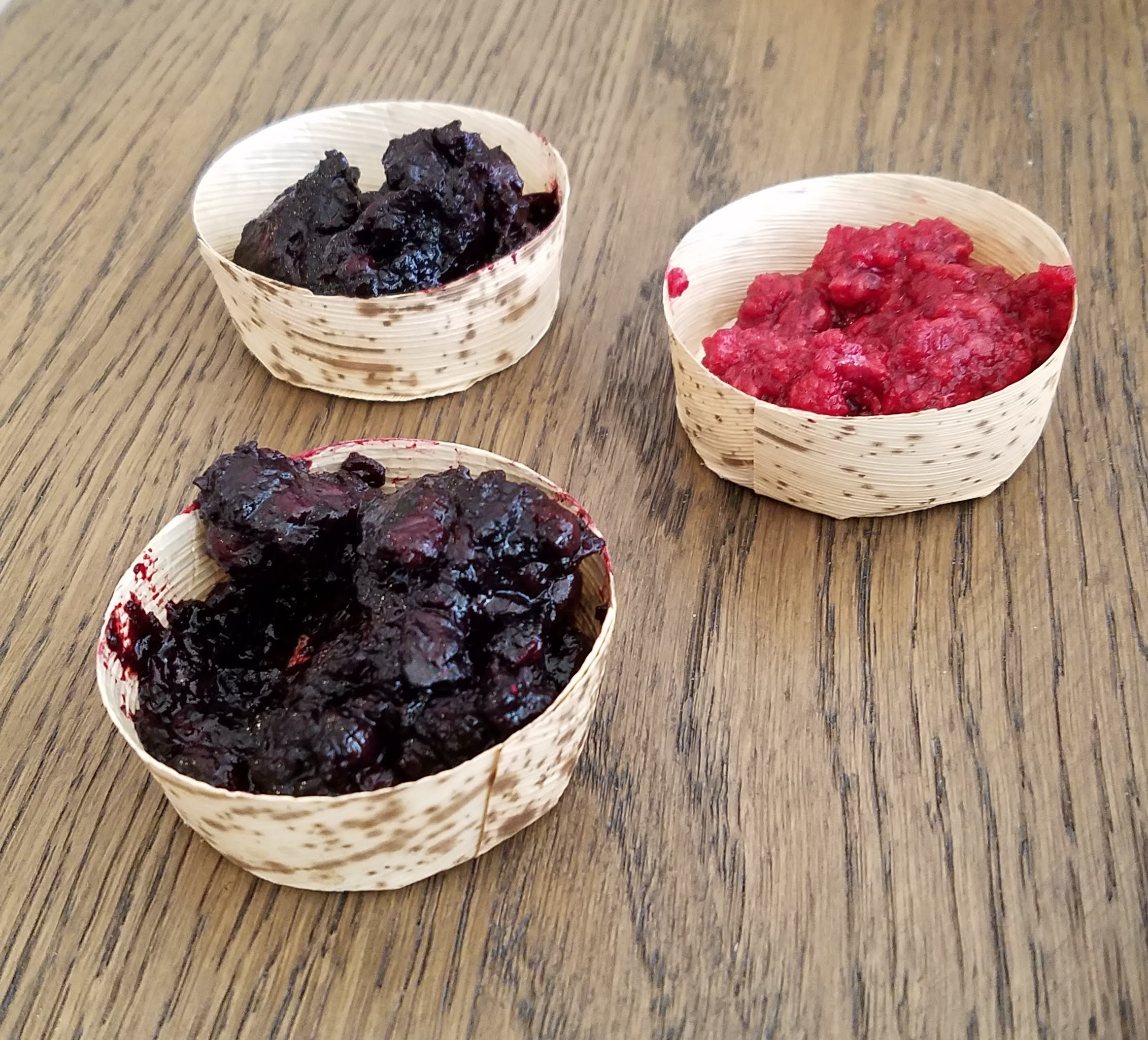
Yet another “green” feature of the Hotel Kong Arthur: jam comes in birchbark cups rather than plastic packets
Besides us, the only people from our original tour group who are still in Denmark are Eric and Pam, with whom we enjoyed breakfast. Mark and Lynn have not yet checked out of the hotel, but they left early to catch a ferry to Sweden, where they plan to spend the day visiting some of Lynn’s relatives. They’ll get back to Copenhagen late tonight and will fly home with us tomorrow.
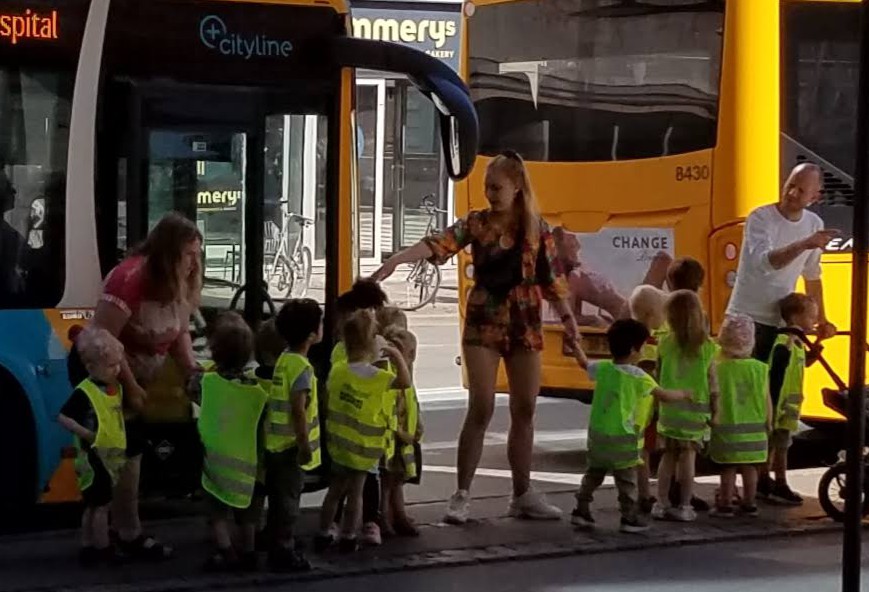
Herding preschoolers onto public transit for a field trip
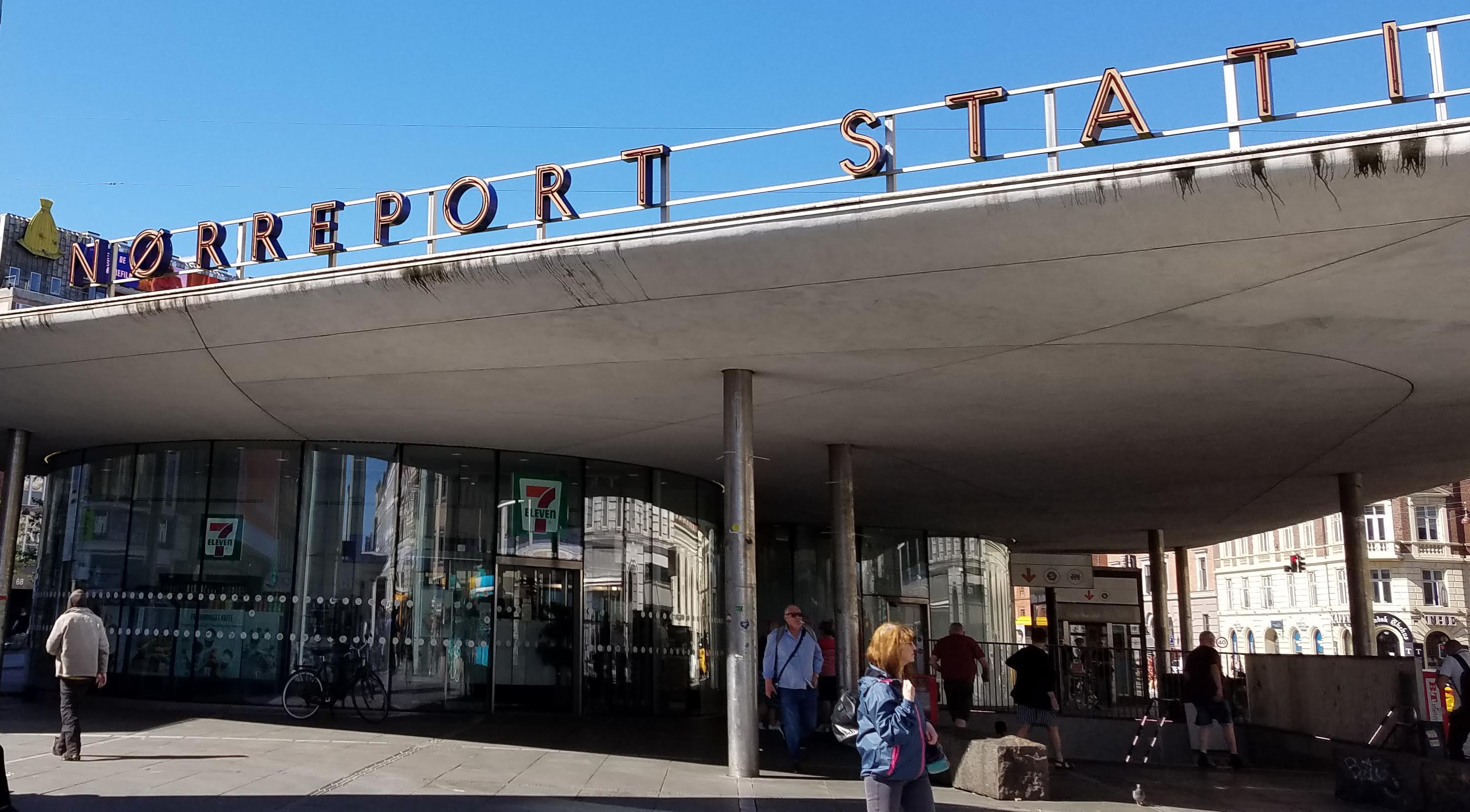
Nørreport Transit Station
After breakfast, the remaining foursome headed for the Nørreport Transit Station, a ten-minute walk from the hotel. Last night we had been undecided about whether to spend today in Roskilde, the former capital and site of the cathedral where Danish royalty are buried, and also of the museum where some thousand-year-old Viking ships are displayed, or in Hillerød, site of Frederiksborg Castle. Both are about an hour away from Copenhagen by train, but one is west and the other is north, so we didn’t think we’d have time to visit both. Pam and Eric were leaning toward Frederiksborg, and then Tara and Todd pushed us in the same direction, saying that it was definitely the best castle in Denmark and we really shouldn’t miss it.
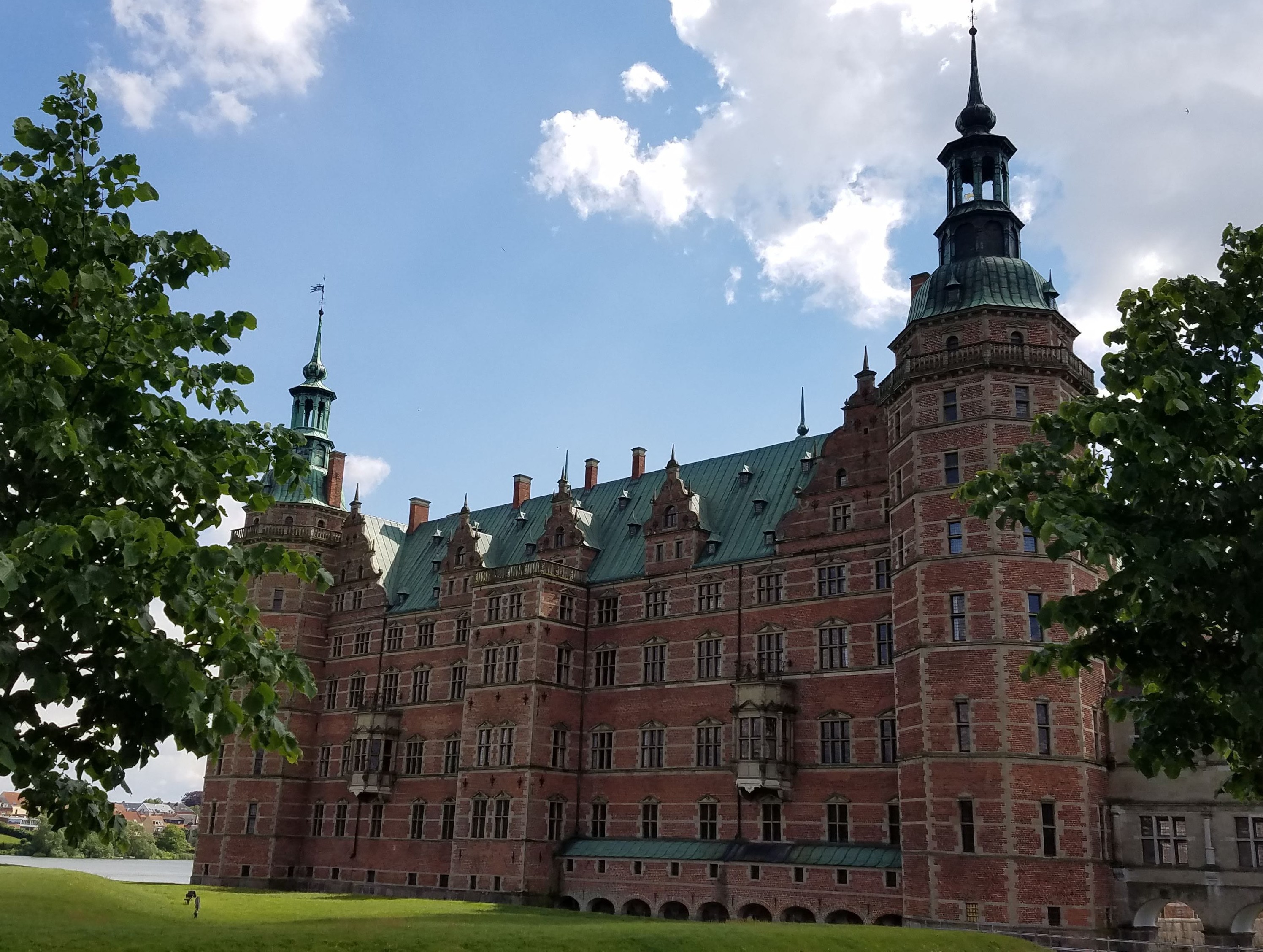
Frederiksborg Castle
For us, one of the main attractions of Frederiksborg Castle—besides the fact that it has been described as “the Versailles of Denmark”—is that it is the home of more artworks that have become iconic in Latter-day Saint culture. These are a series of paintings of the life of Jesus Christ by Carl Heinrich Bloch (1834-1890) that were commissioned to decorate the royal prayer chamber after much of the castle was severely damaged by fire in 1859. Many of these paintings have become ubiquitous as illustrations in LDS instruction manuals and on the walls of our church buildings, so, as with Thorvaldsen’s Christus, we were curious to see the originals.
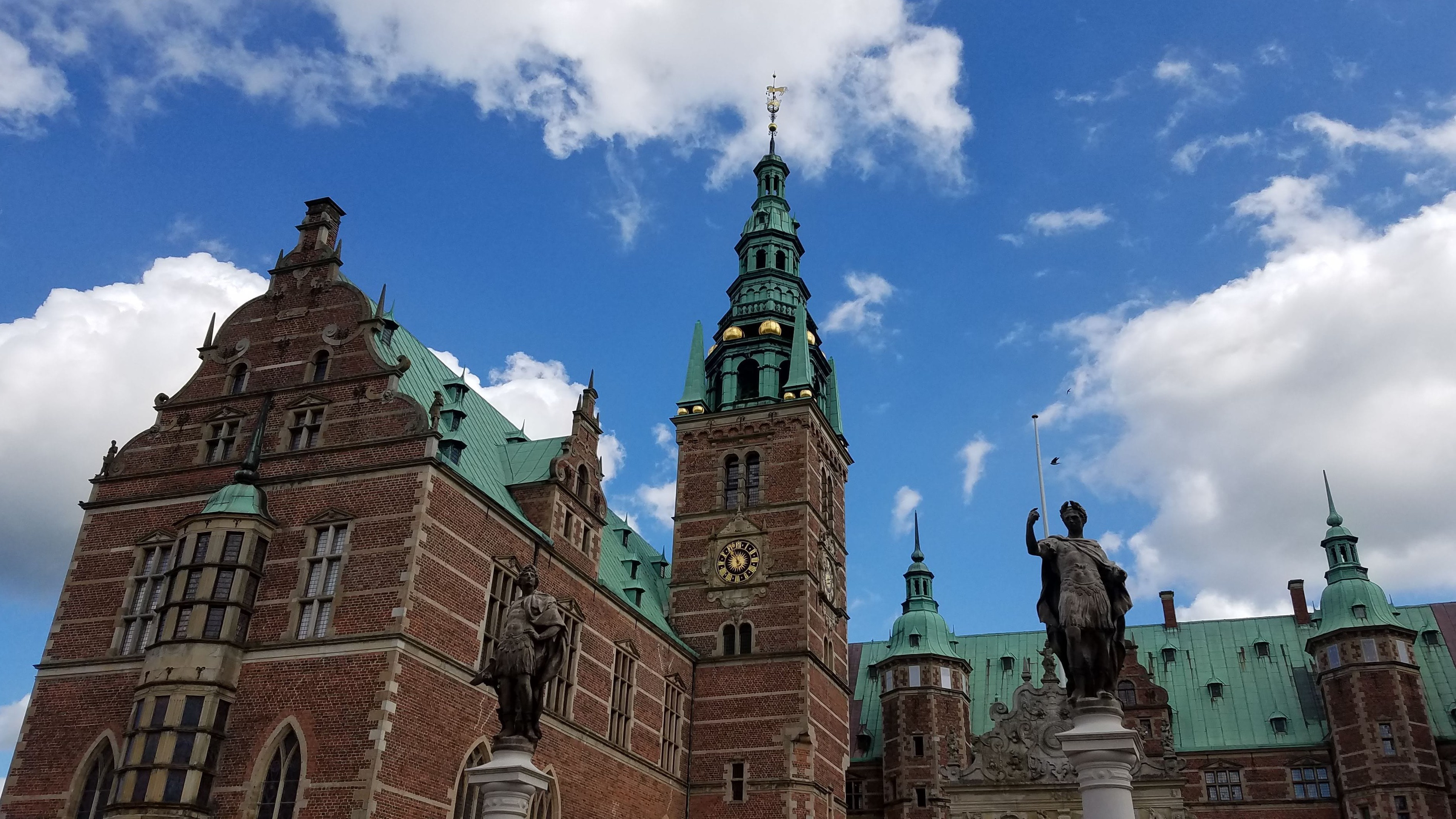
The castle complex is large and includes a number of buildings. Because we didn’t want to miss Bloch’s Life of Christ paintings, we asked a guard at the gatehouse exactly where to find them.
“They’re in the King’s Oratory behind the chapel,” he said, pointing toward the large wing next to the belfry. Then he added, “You must be Mormons. Mormons always want to see the Bloch paintings.”
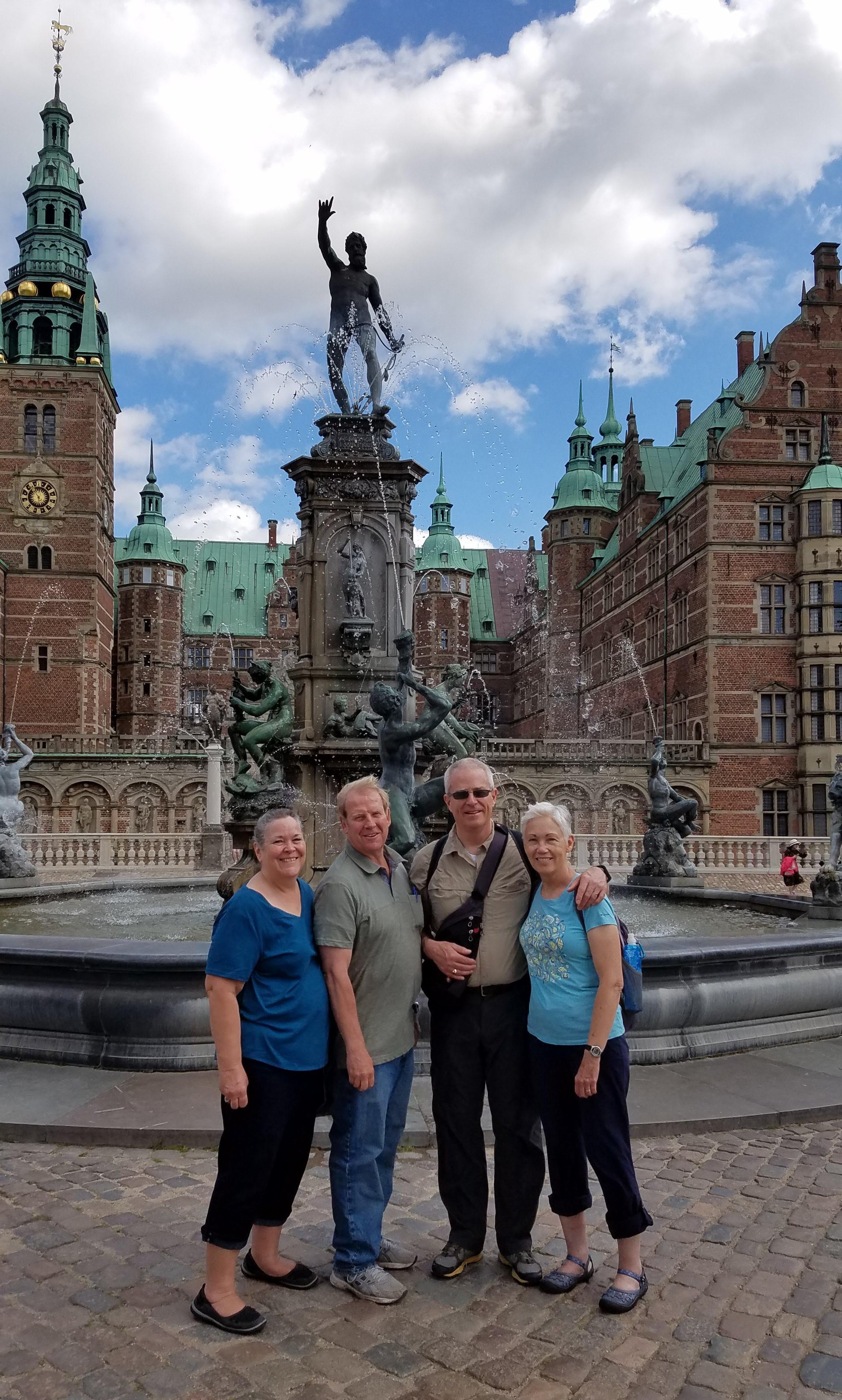
Tara, Todd, Michael and Nancy
We nodded and laughed as we continued toward the entrance behind the spectacular Neptune Fountain, and then—speaking of Mormons—we were surprised to see Tara, Todd, and Todd’s sisters walking toward us. They had arrived earlier and were now on their way out, but it was fun to spend a few more minutes with them.
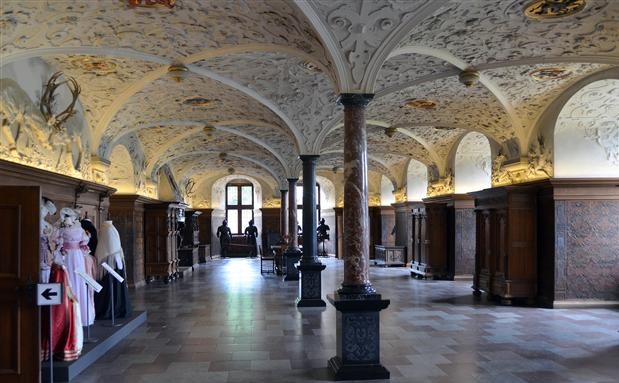
The Rose Hall

Renaissance-era dress from the costume collection
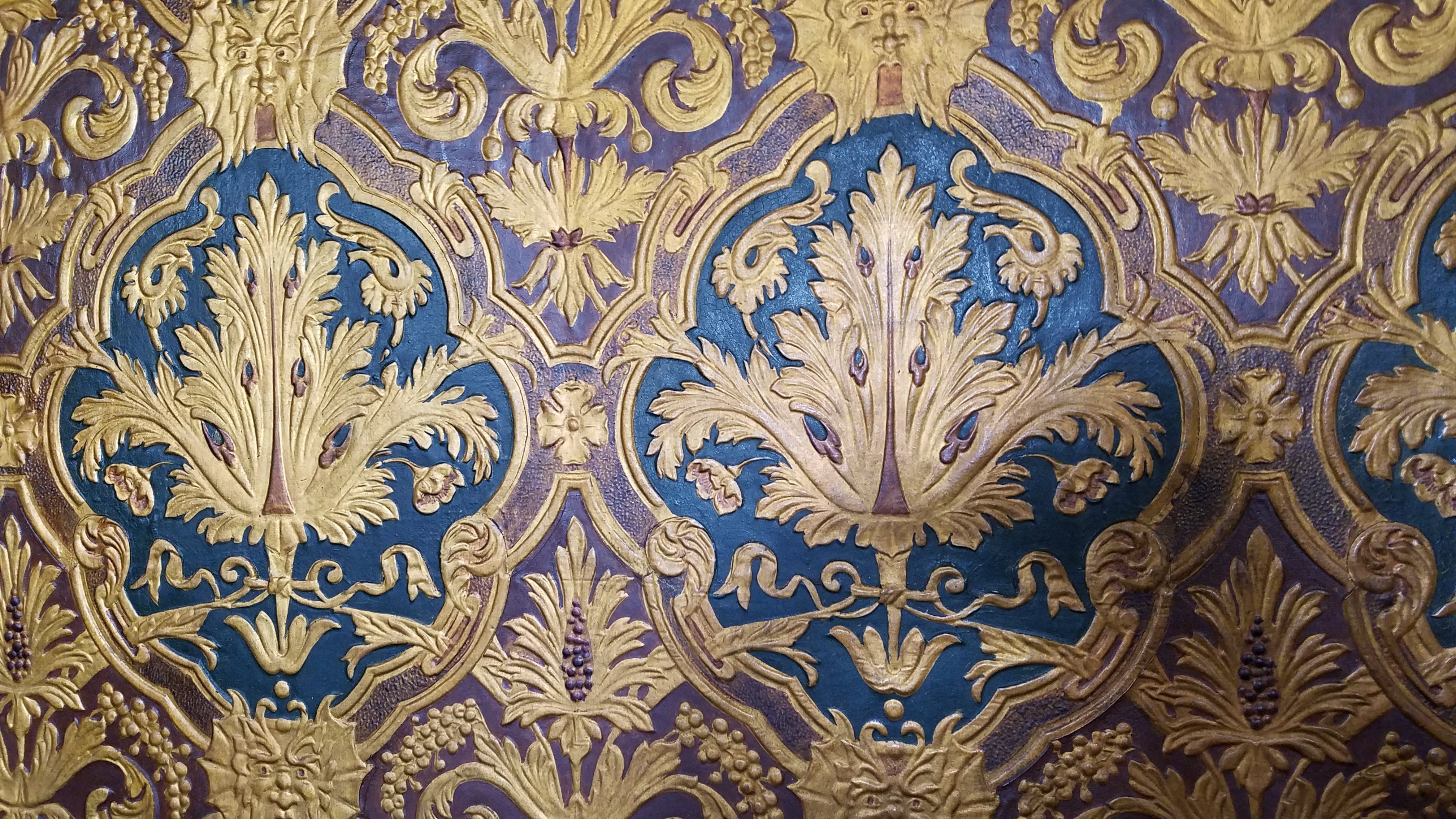
Detail of leather wall covering in The Rose
Our tour of the castle began with The Rose, a hall with an exquisitely decorated stucco ceiling that was used as the court dining room, but now holds a display of historic costumes and armor. It is on the ground floor in the section of the castle that was reconstructed following the 1859 fire. Fortuitously, several detailed architectural drawings and paintings of Frederiksborg Castle had been created before the fire occurred, so the restoration was based both on those and on original building plans found in the archives. Although the castle was in use as the residence of Frederik VII when the fire broke out, the king concurred when brewing magnate J.C. Jacobsen proposed that the restored palace be turned into a national history museum—and donated a lot of money to kickstart the project. The museum opened in 1882 with paintings and furnishings that had escaped the flames, but the collection has continued to grow as historically significant art and artifacts from other places have been gathered to Frederiksborg.
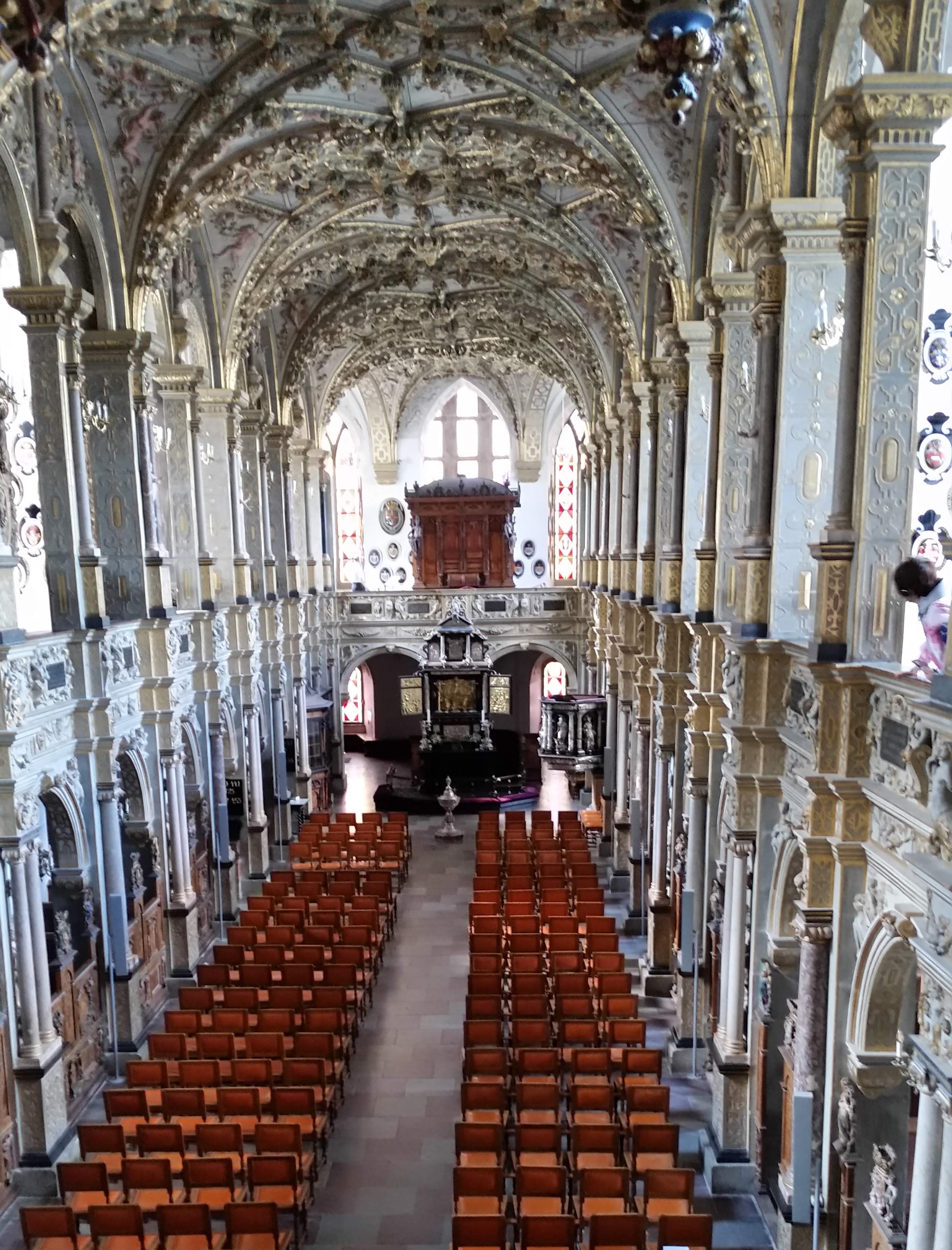
The chapel
Next on our tour was the chapel—truly an impressive sight. Completed in 1606, its vaulted ceiling is decorated in the Renaissance style with stucco filigree and gold leaf. The chapel is one of the few parts of the palace complex that survived the 1859 fire, and it continues to be used for state occasions such as royal weddings and induction ceremonies for the Order of the Elephant, Denmark’s highest chivalric award.
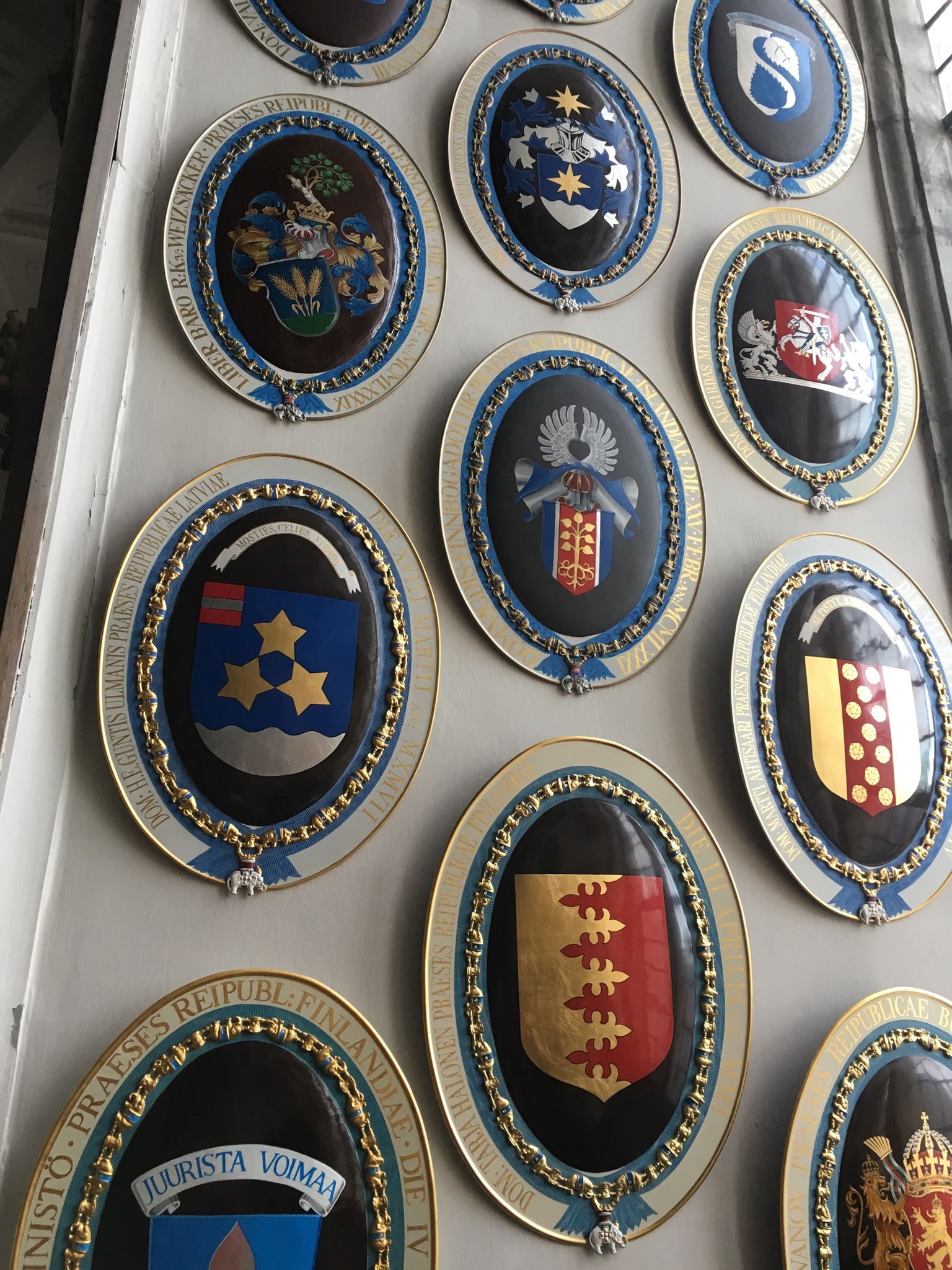
Plaques of Order of the Elephant recipients
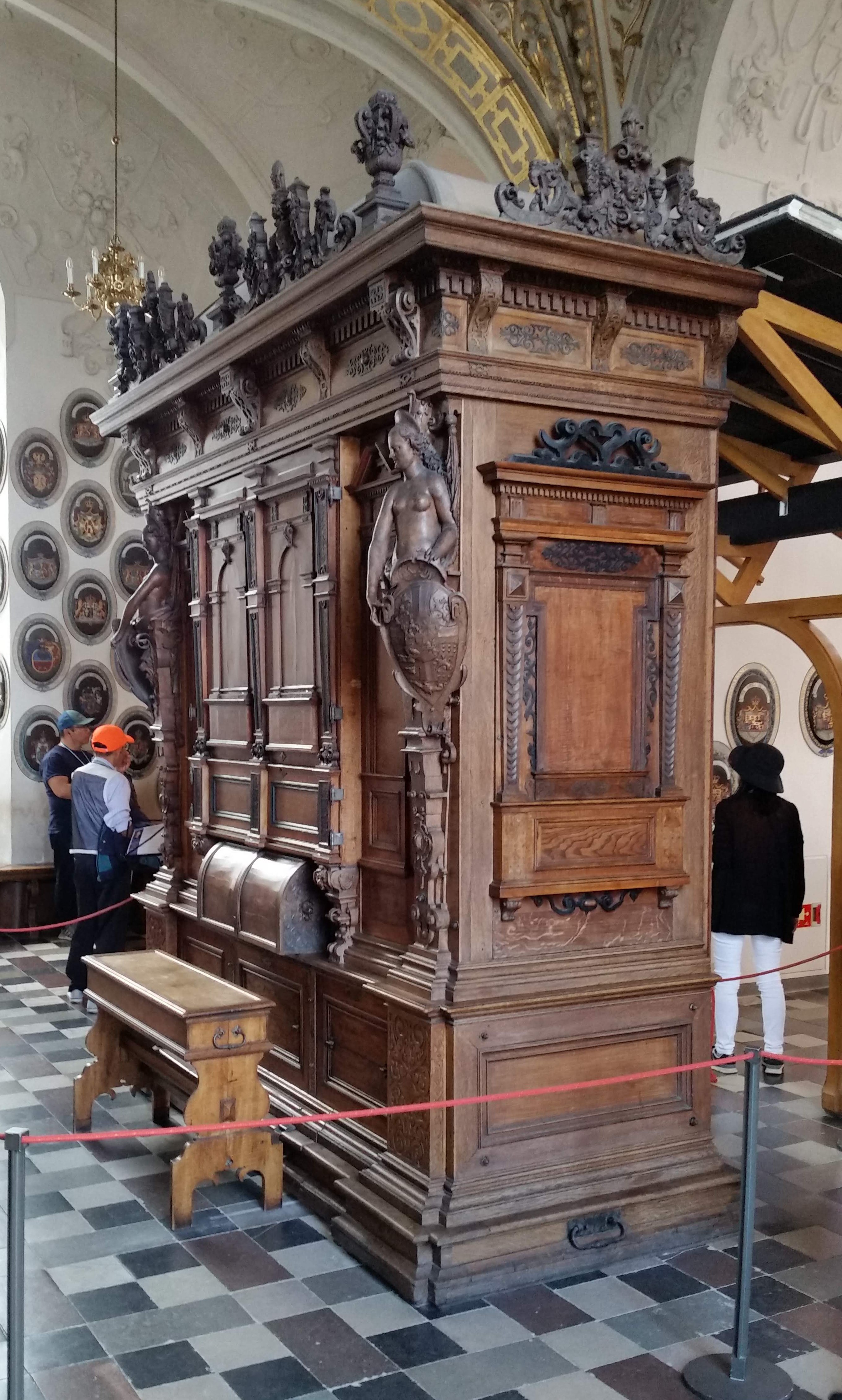
The chapel organ was built in 1610—the last project of Esajas Compenius, one of Europe’s most renowned organ builders
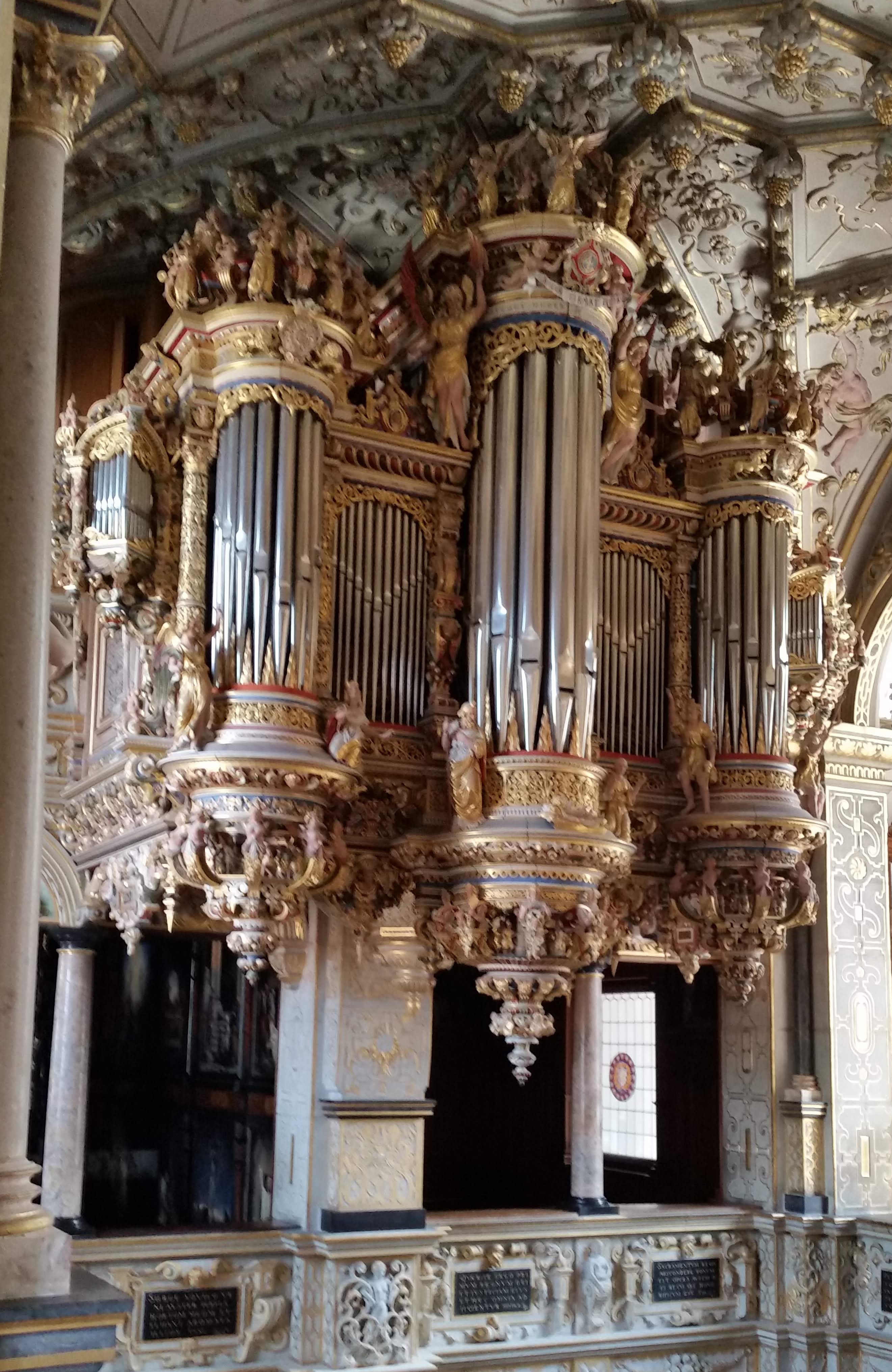
All 1,001 organ pipes are made of rare woods
Plaques displaying the coats of arms of the knights of the Order cover the pillars at one end of the chapel. Most of those inducted into the Order of the Elephant are heads of state; some names we recognized included Prince Charles, Winston Churchill, and Dwight Eisenhower. (It seems curious that the elephant would be used as the symbol of Denmark’s knights, but the image can be traced back to imperial Rome, whose army generals made occasional but very effective use of elephants to intimidate their enemies.)
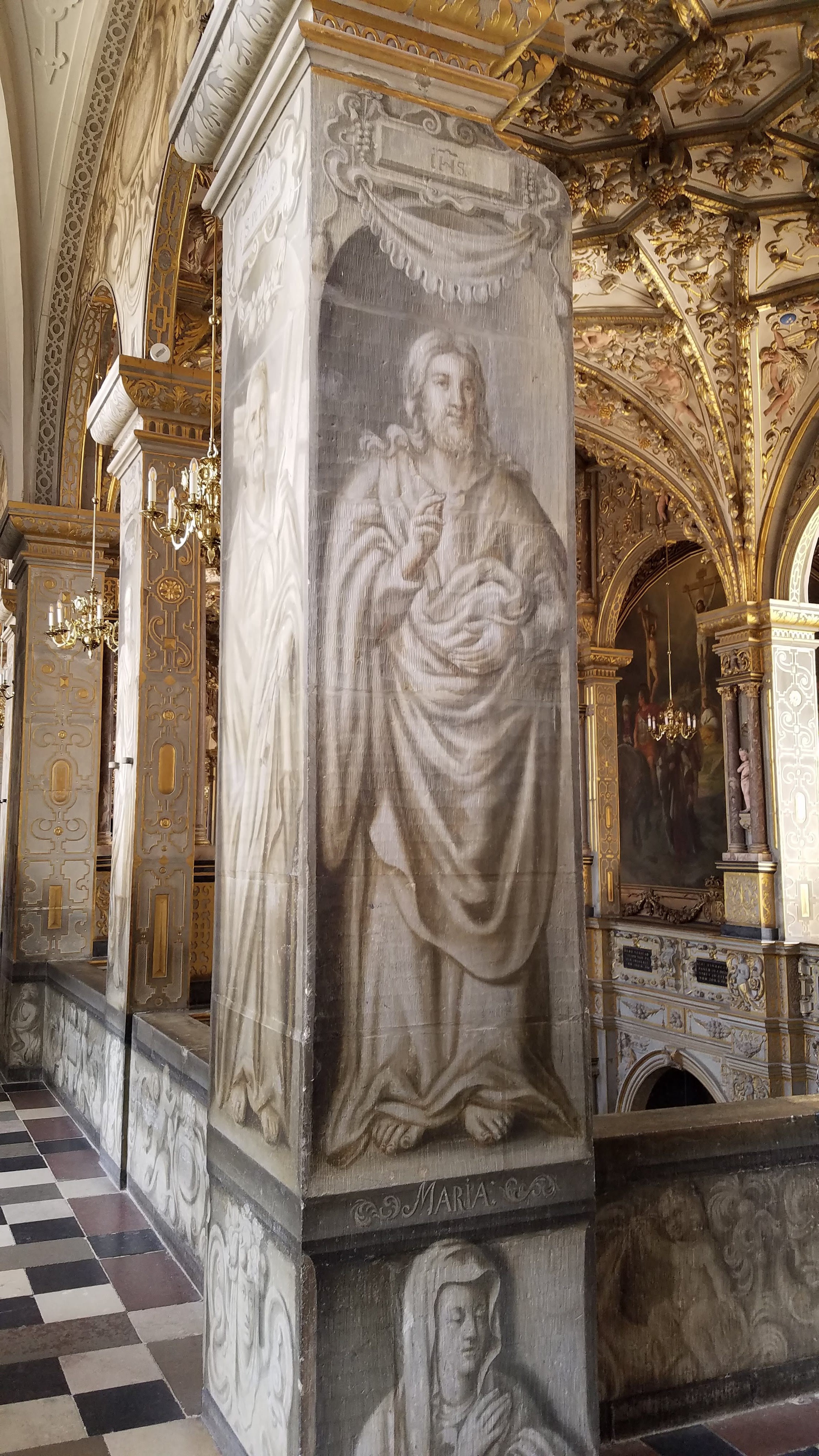
Some pillars in the chapel feature grisaille frescos (paintings that mimic sculpture)
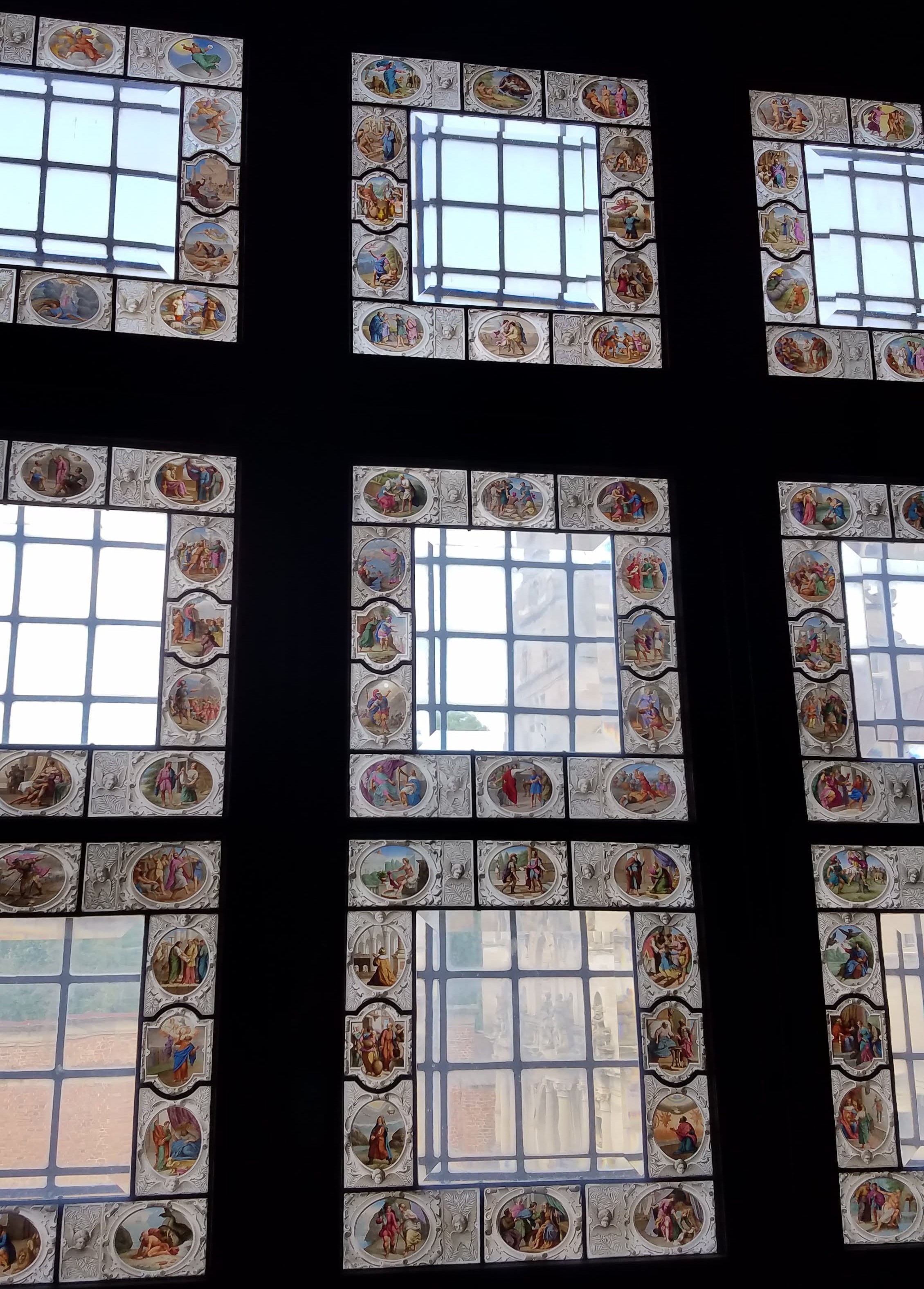
Small windows in one wall of the King’s Oratory are the room’s only source of illumination. Each is surrounded by miniature paintings on glass depicting other Bible stories
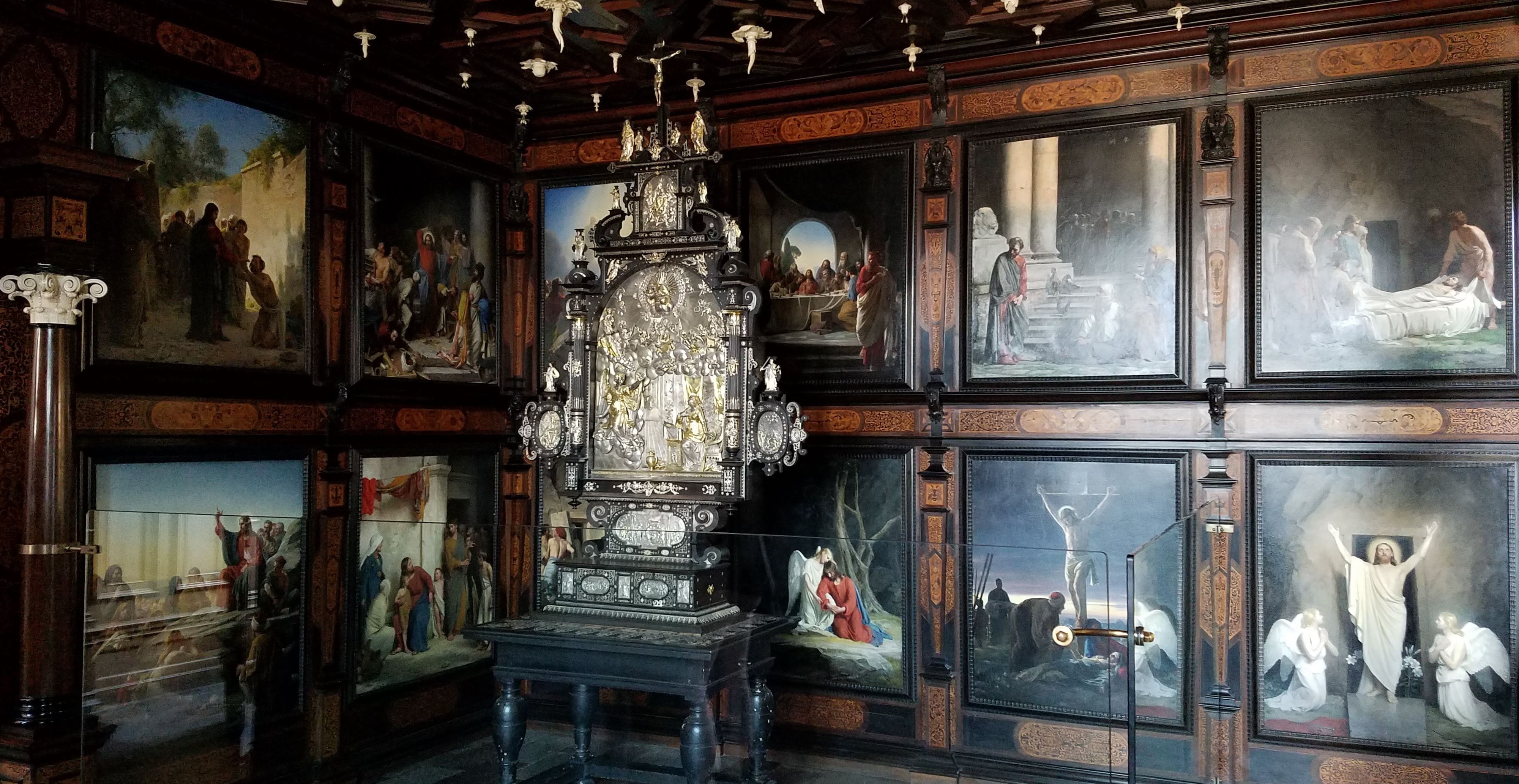
Carl Bloch’s paintings cover the walls of the King’s Oratory
The King’s Oratory, where Carl Bloch’s twenty-three paintings of the life of Christ are mounted, is a surprisingly small, poorly lit chamber connected to the upper gallery of the chapel. One can easily imagine the king coming into this space to privately pray and meditate on the Savior’s life and teachings—until you remember that by the time the paintings were completed, kings no longer occupied Frederiksborg Castle.
Unfortunately, it’s also easy to pass by this little room without even noticing the paintings, as Pam, Eric, and Michael did before Nancy beckoned them back. Some of Bloch’s images are very familiar: the Nativity, Christ and the Children, the Woman at the Well, the Last Supper, Peter’s Betrayal, the Crucifixion; but others we’d never seen before. Many in the second category are those with details that don’t fit comfortably into Latter-day Saint iconography—notably, angels with wings, and the picture of John baptizing Jesus by using a shell to dribble water onto his head rather than fully immersing him in the Jordan. But the wonder of these paintings is in the details the artist chose to include. One of Nancy’s favorite secondary images is in the Sermon on the Mount, where a child in the throng of listeners reaches toward a butterfly that has landed on the bowed head of the person seated next to him. To her, that act symbolizes both our human tendency to let little things distract us and our desire to capture fleeting moments of beauty and inspiration.
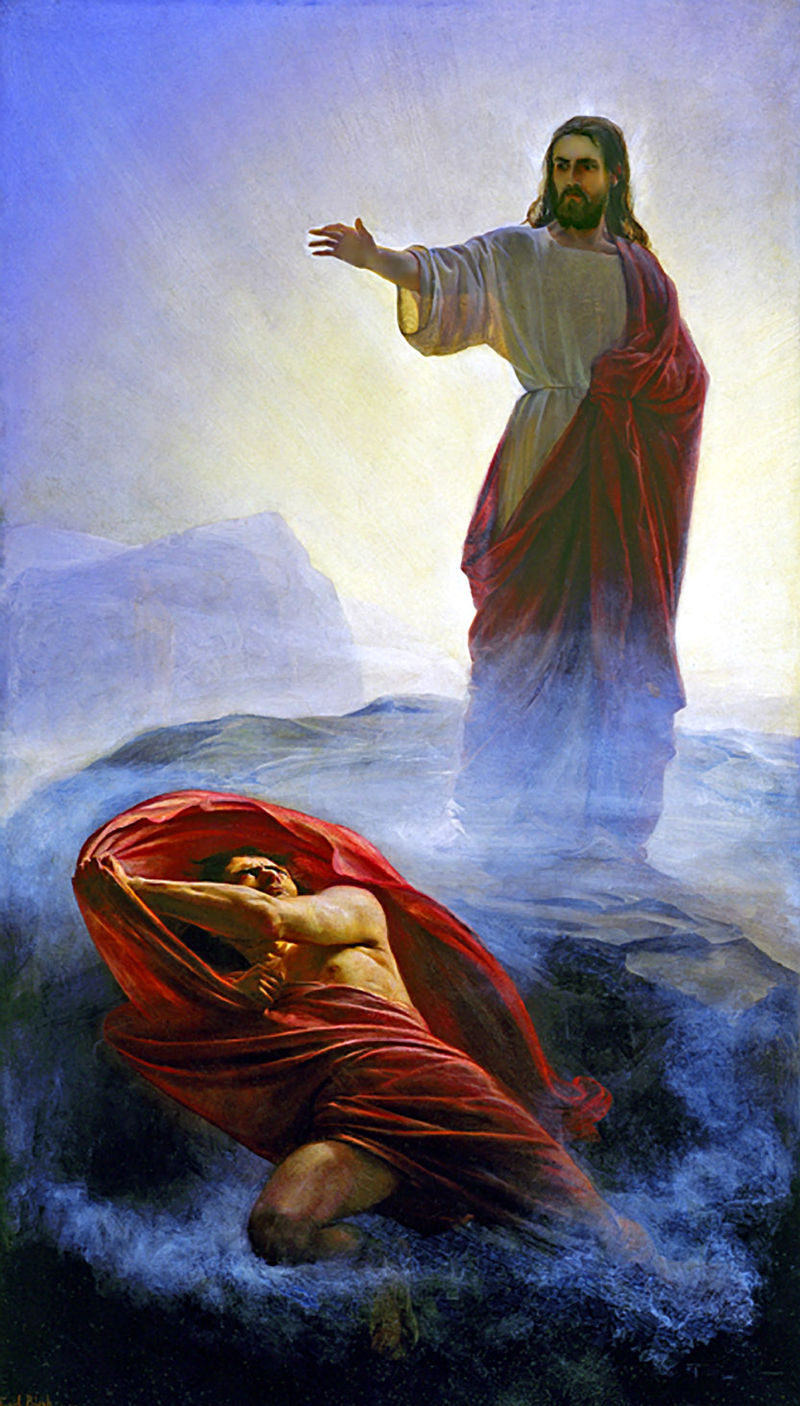
“Temptation of Jesus” by Carl Bloch
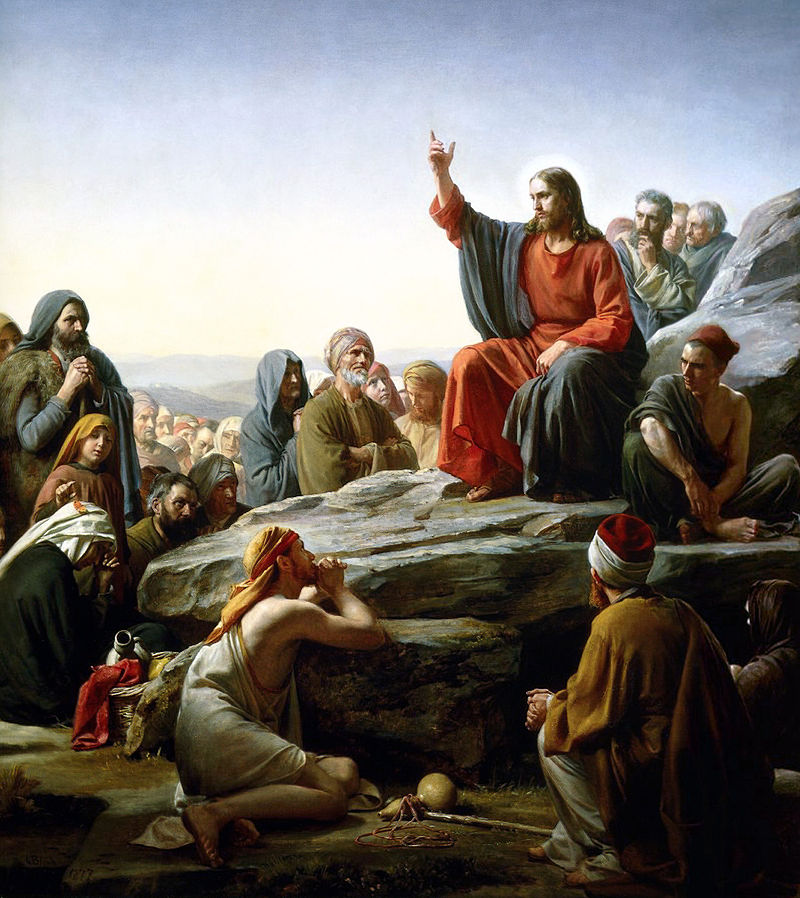
“Sermon on the Mount” by Carl Bloch
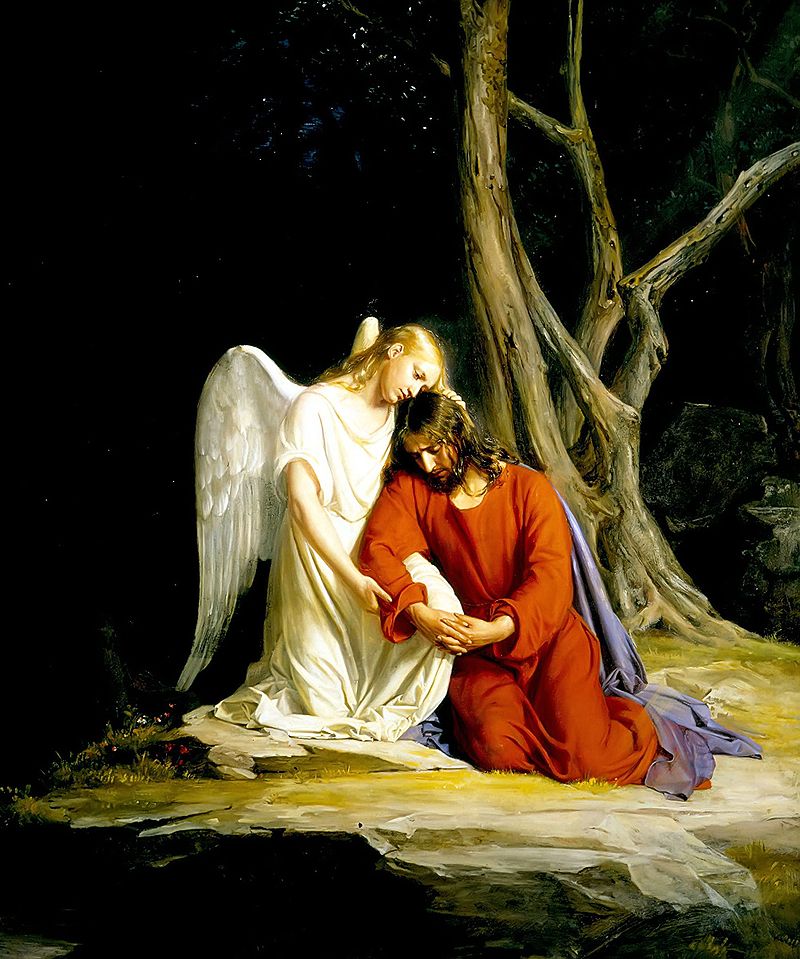
“Gethsemane” by Carl Bloch
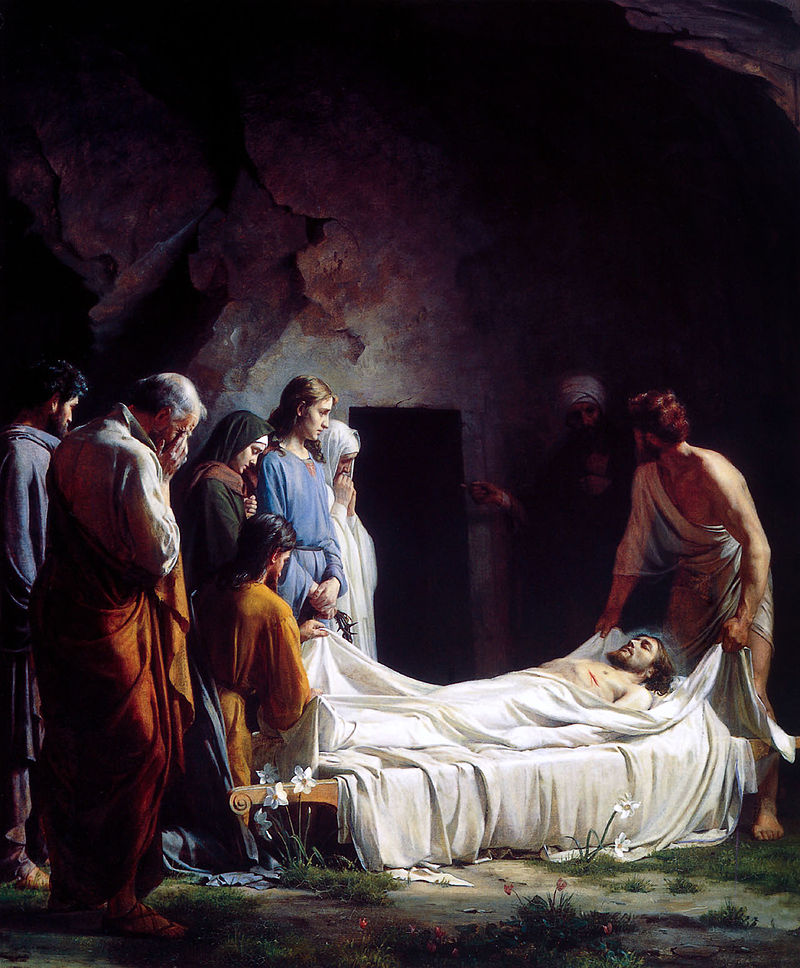
“Burial of Christ” by Carl Bloch
Beyond the Oratory is a series of rooms that feel more like a contemporary museum, with displays illustrating early Danish history. Currently, there is a special exhibit commemorating the 800th anniversary of the Dannebrog. A door on the far side of that exhibition opens onto the Privy Passage, a long picture gallery whose elaborate baroque decor signals a re-entry into the seventeenth-century. Like the chapel, the Privy Passage and its original artwork escaped extensive fire damage. It leads to the Audience Chamber, the only part of the castle’s former living quarters that remains intact from the reign of Christian V (1670-1699). One of the most notable features of the Audience Chamber is that many of its surfaces are trompe l’oeil paintings created by skilled artisans to resemble marble pillars, stone sculptures, inlaid wood, and even drapery fabric. Another unique element is the lift in the corner, built to allow Christian V to more easily move upstairs from the ground-floor entrance.
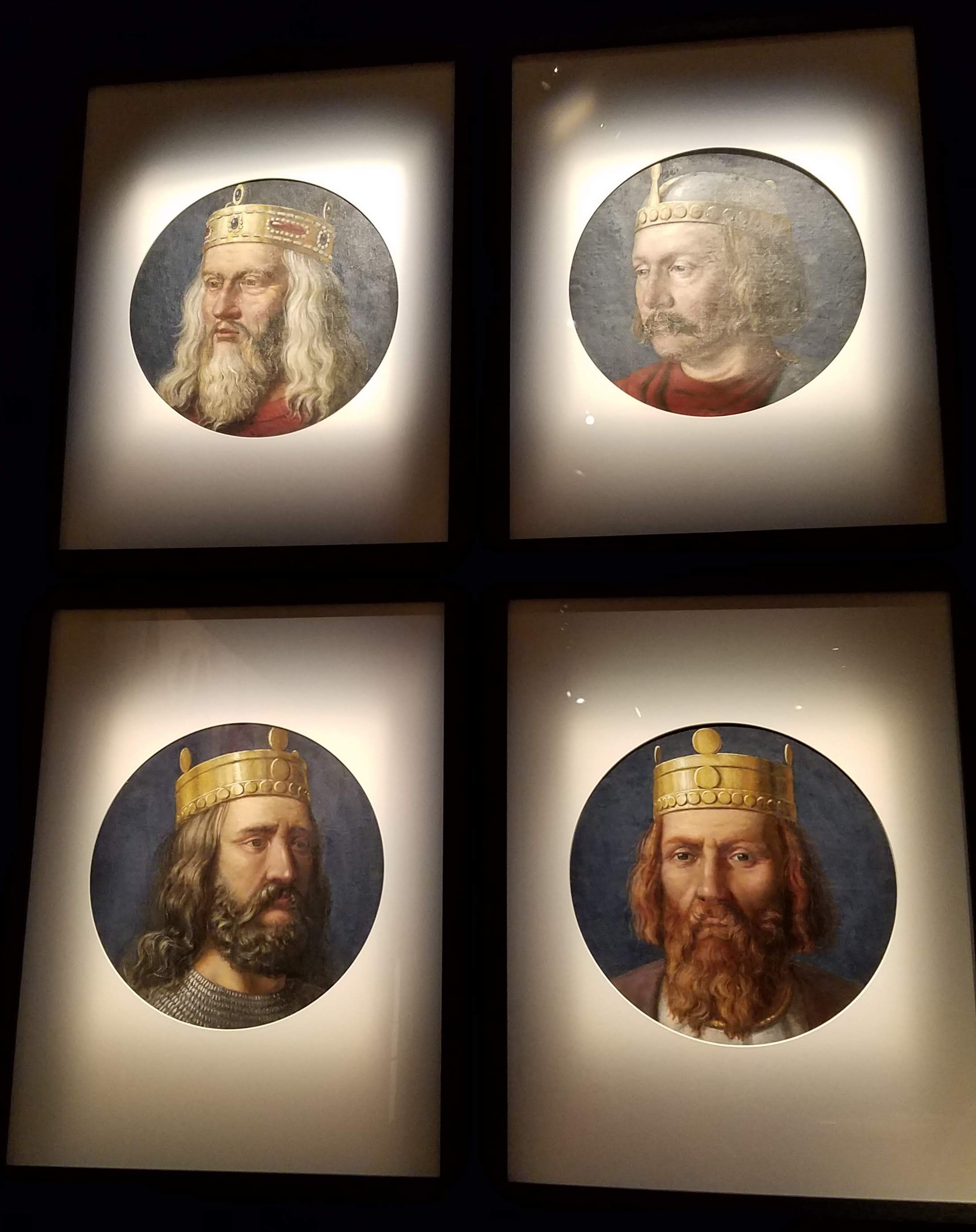
During the 11th century, four Danish kings also sat on the throne of England: Sven Forkbeard, Canute the Great, Harald Harefoot, and Harthaknud
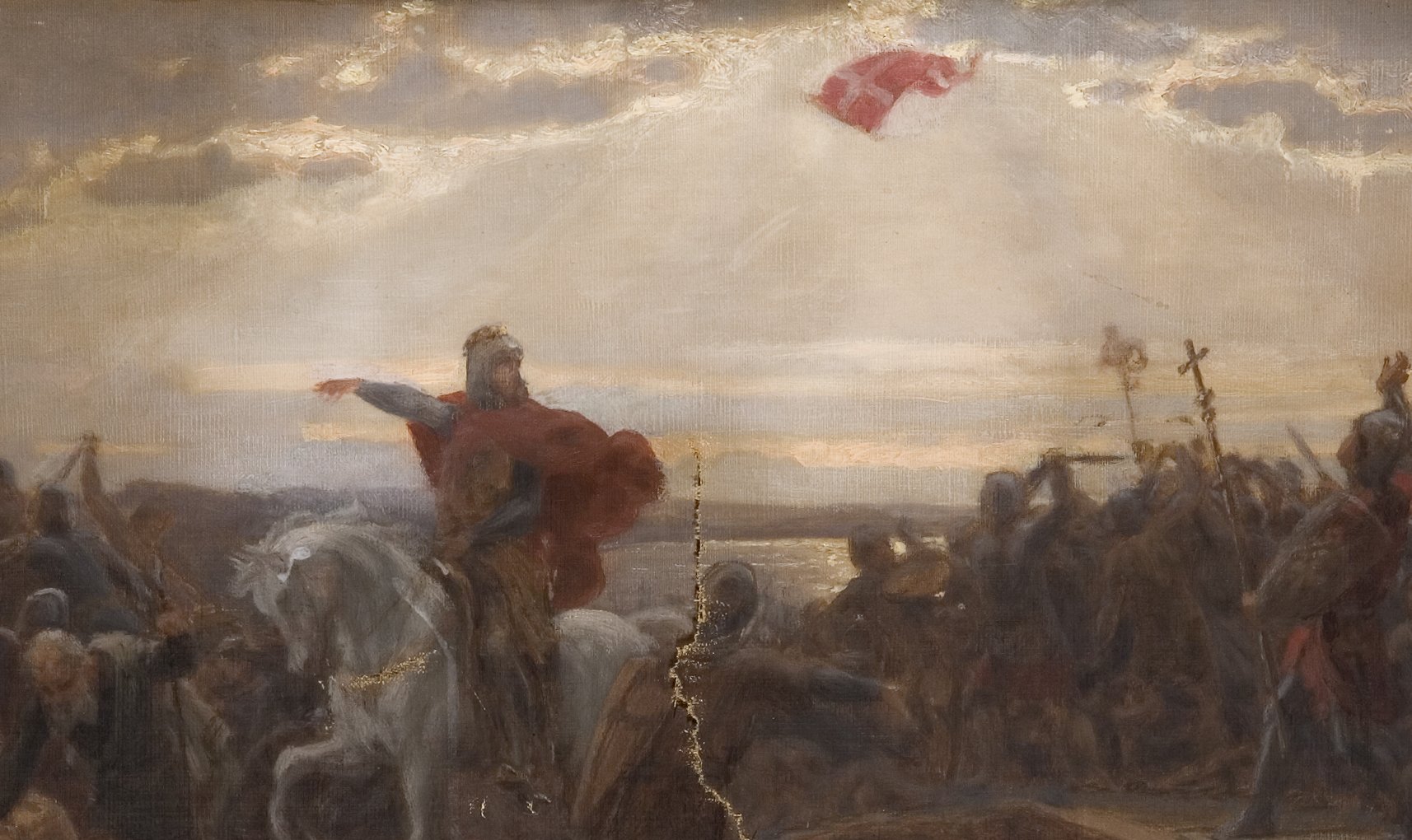
Oil sketch by Henrik Olrik, depicting Valdemar’s victory over Estonian pagans and the miraculous appearance of the Dannebrog
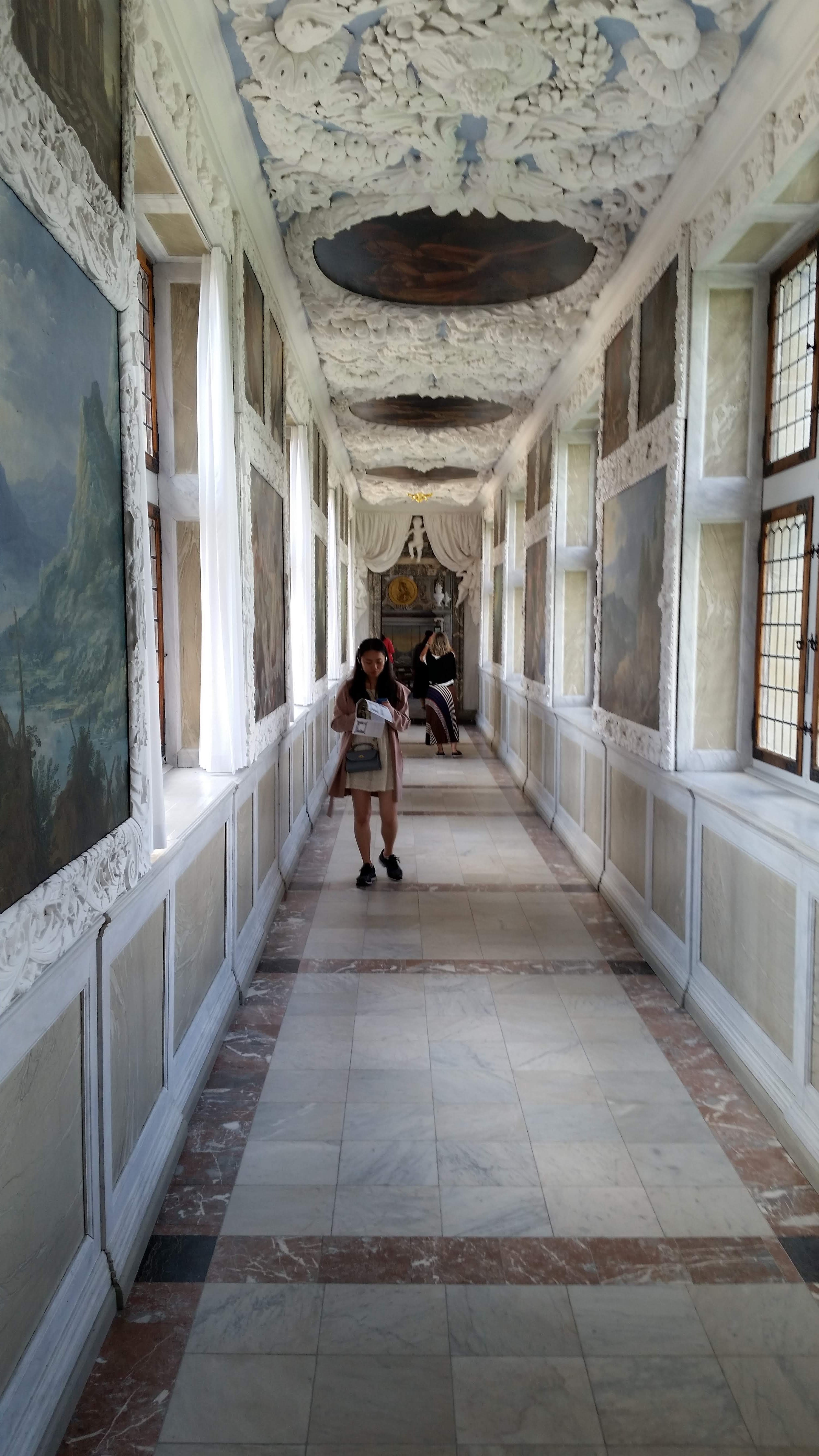
The Privy Passage
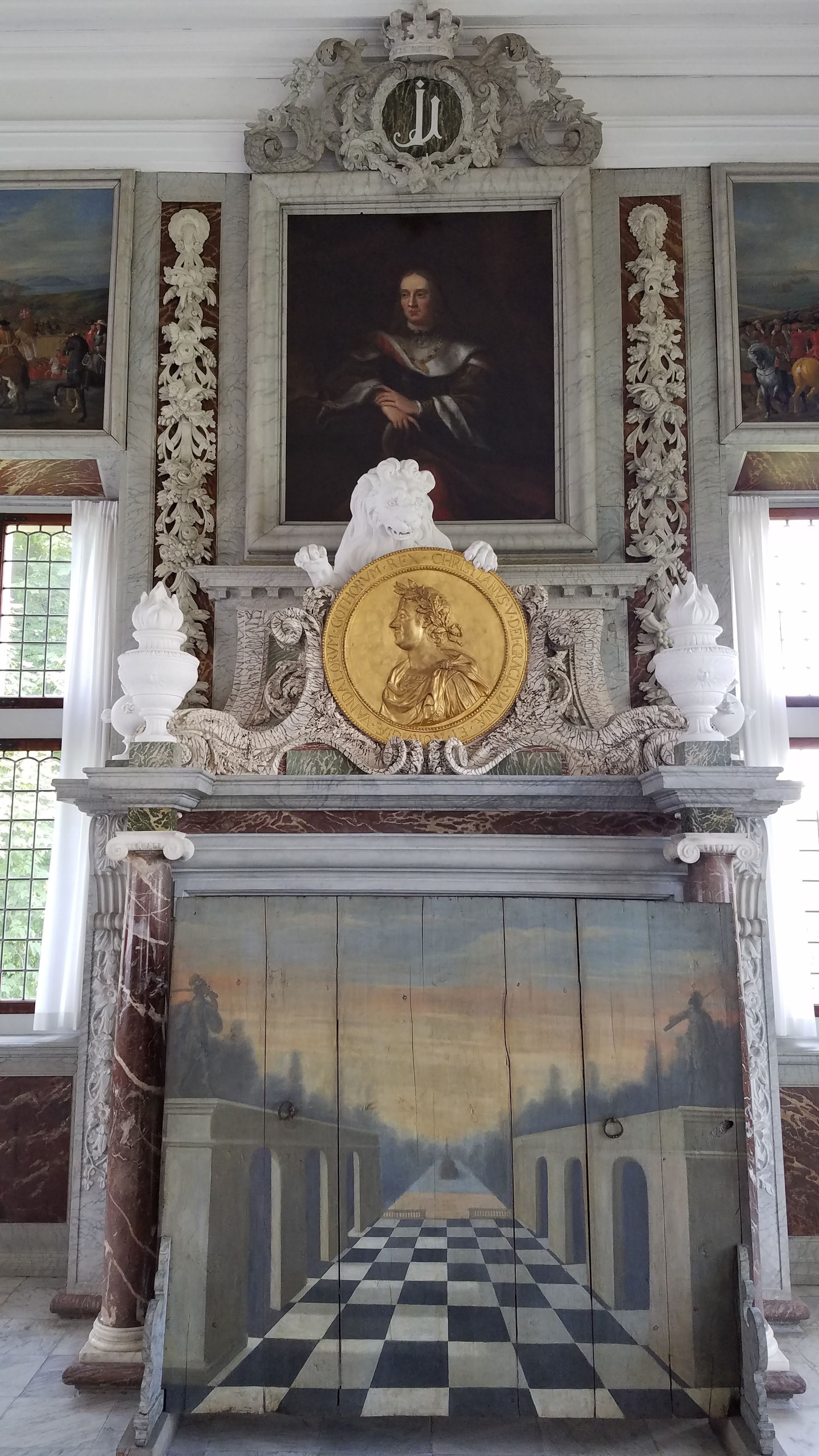
Portrait of Christian IV in the Audience Chamber, over a trompe l’oeil fireplace screen
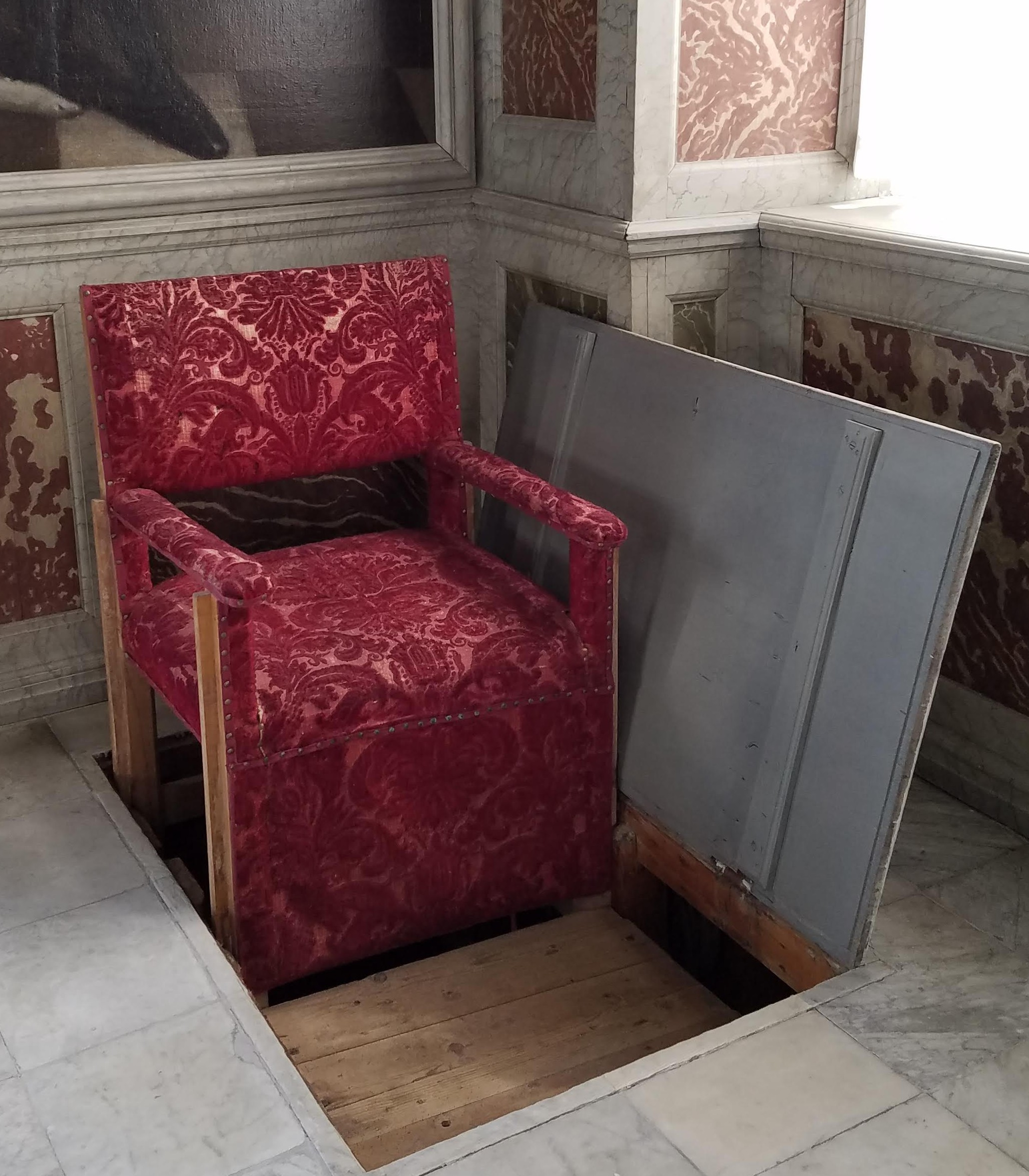
The king’s lift
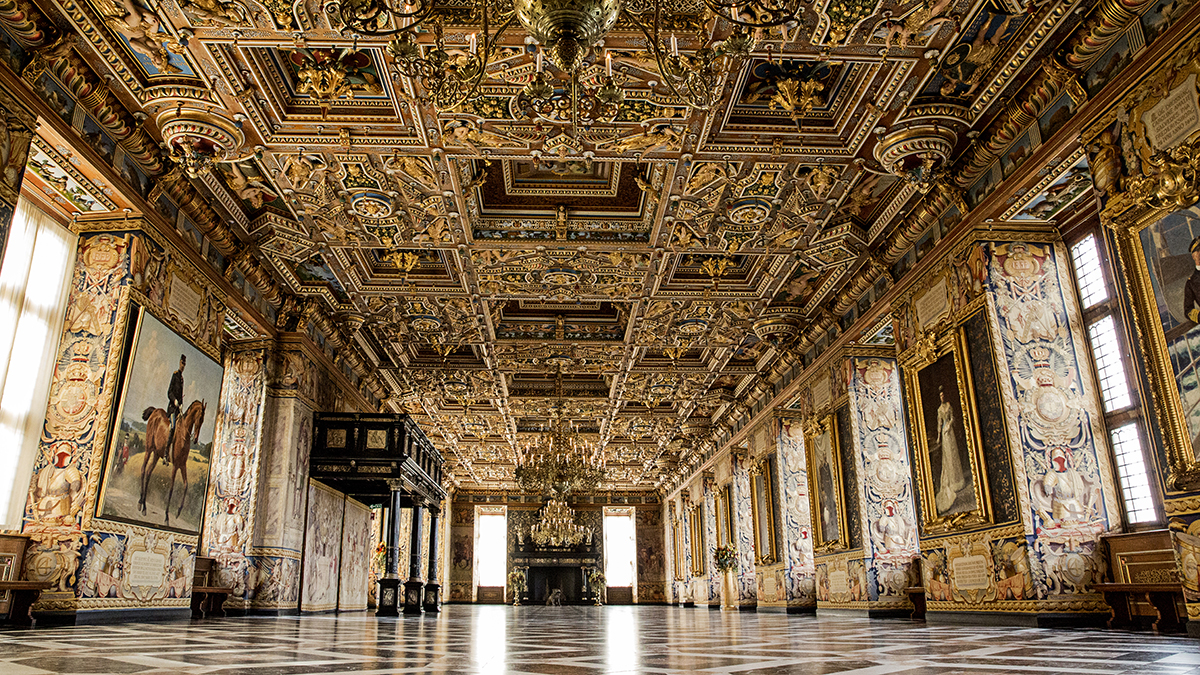
Great Hall
The Great Hall extends along the full length of the west wing on the floor above the chapel. This ballroom was meticulously restored after the 1859 fire, using as many pieces of the original gilded ceiling as could be salvaged. Tapestries depicting scenes from the life of Christian IV were recreated at the same factory where the original hangings were woven in the sixteenth century, using the artist’s original cartoons. However, most of the large paintings along the walls portray more recent Danish monarchs and their families.
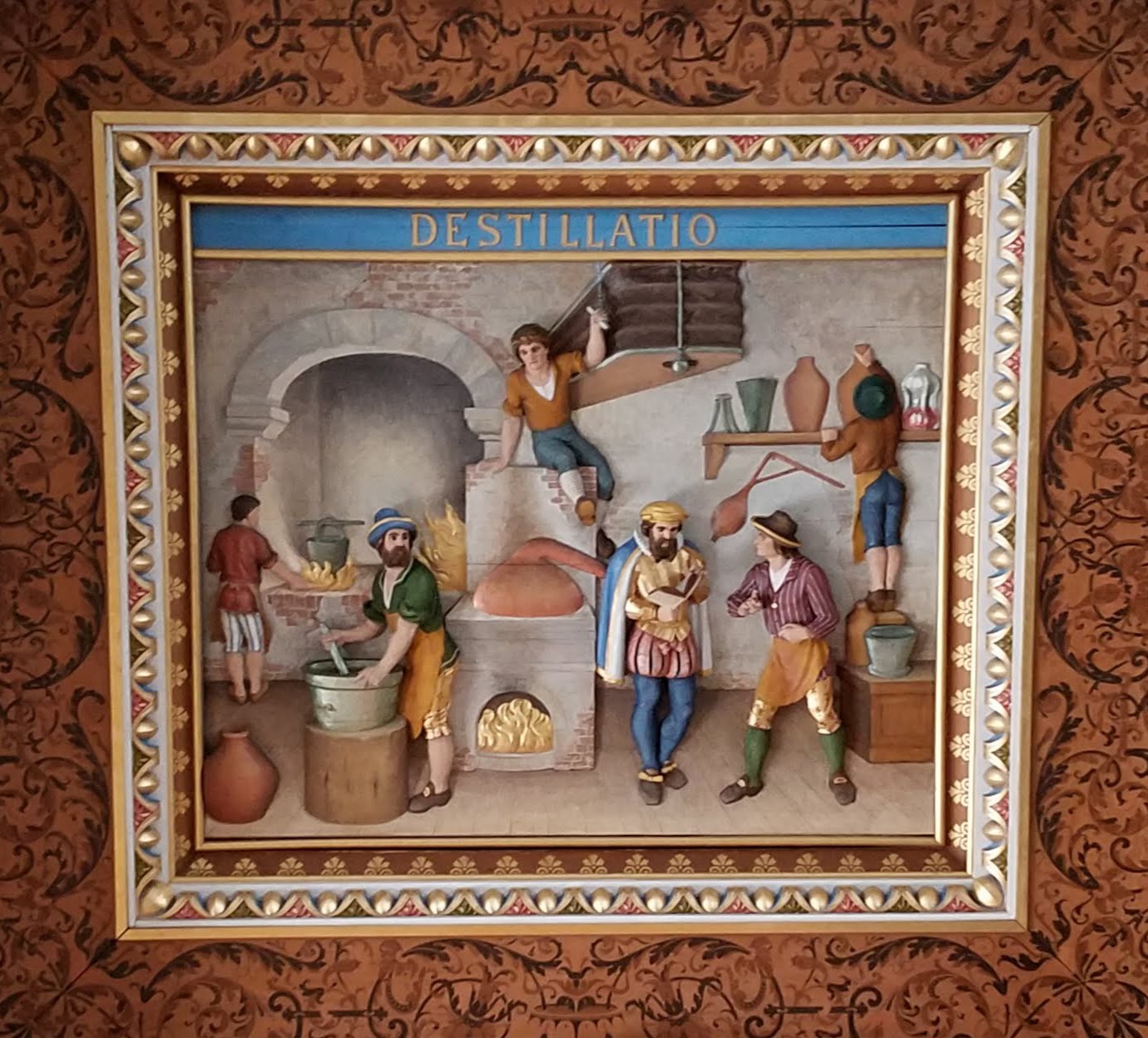
Ceiling relief honoring distillers
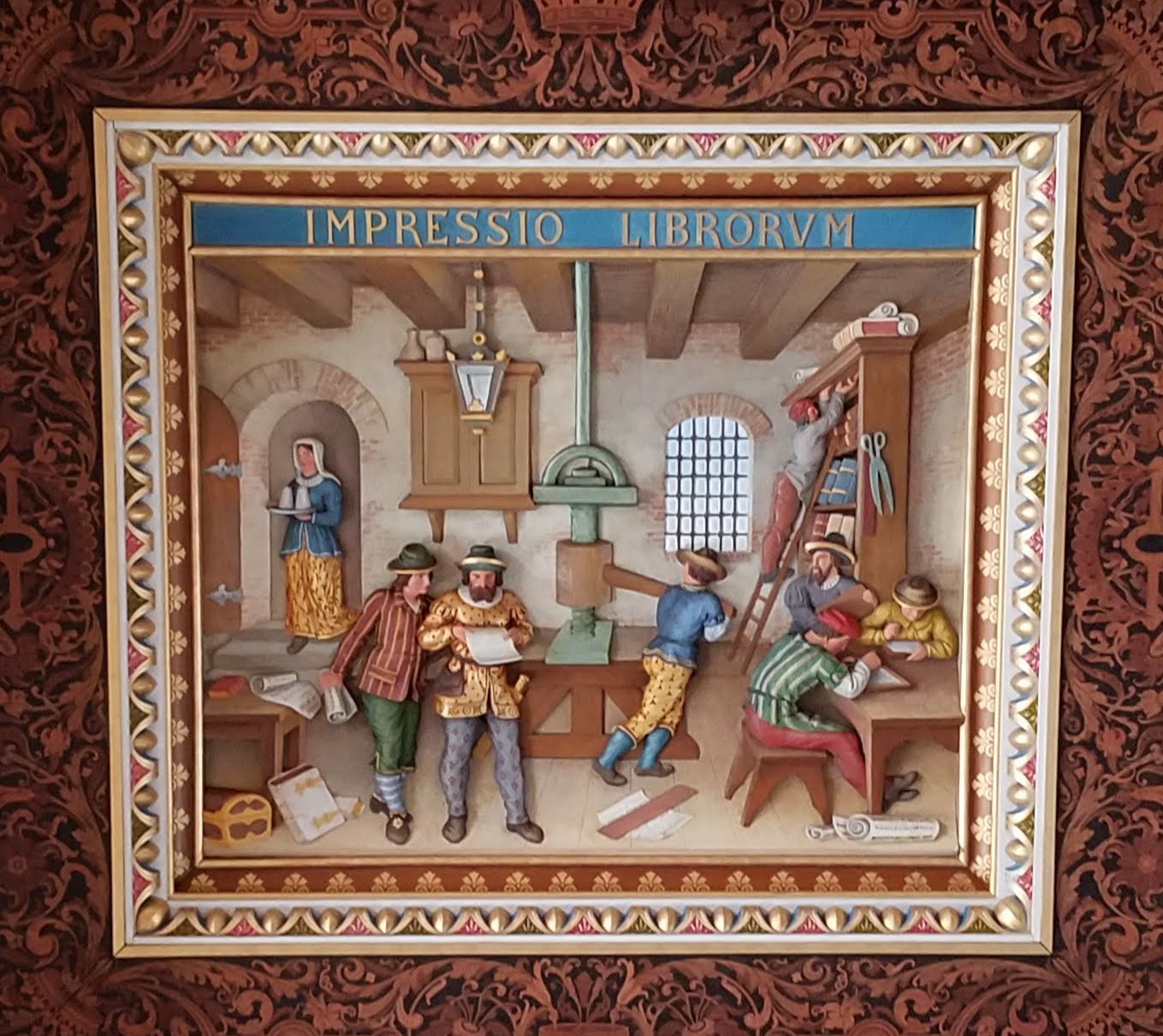
Ceiling relief honoring book printers
The ceiling also includes a series of painted wooden relief carvings that celebrate skilled laborers. We’re not sure whether these were part of the original decor or a nineteenth-century addition, but they certainly are an unusual feature for a room dedicated to elegant parties for the leisure class.
The structure and architectural decor of other rooms in Frederiksborg Castle also have been restored to their former splendor, but most have become display galleries for the National History Museum and do not necessarily reflect their original purposes. Nevertheless, there are many rich details to be seen on the castle’s ceilings, walls, and floors, in addition to the portraits, furnishings, and other artifacts that make up the museum’s collection.
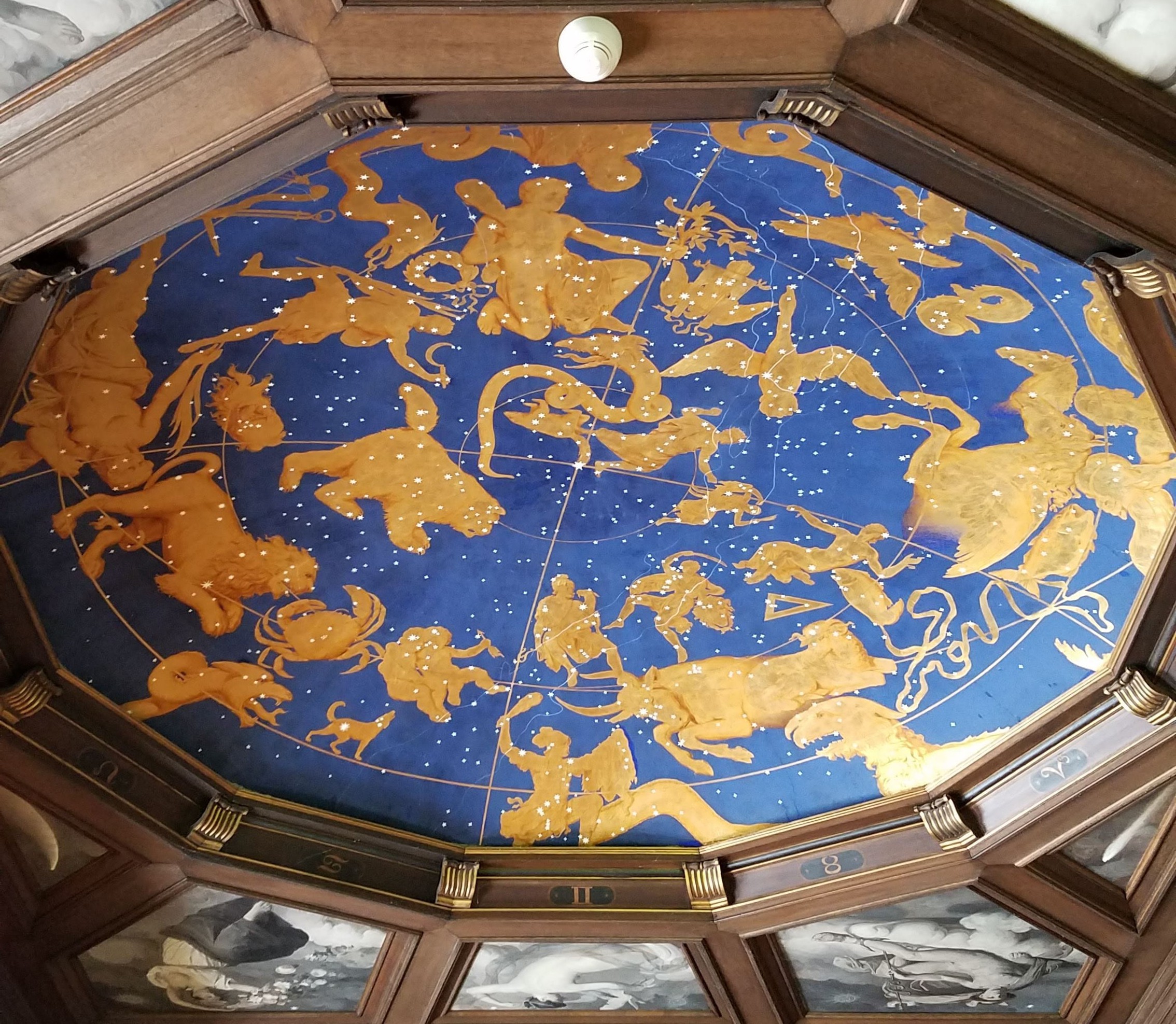
A ceiling painted with a guide to the constellations

Paneled ceiling
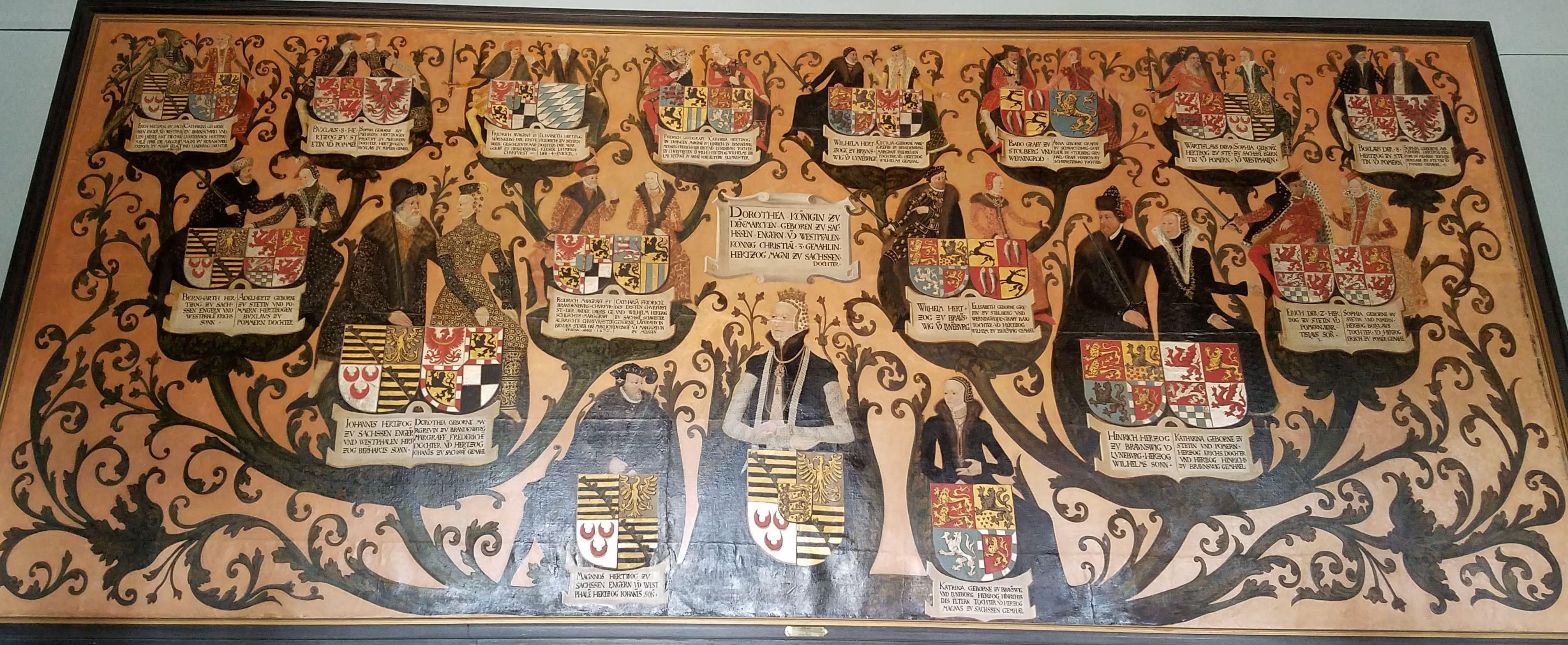
One of many illustrated royal family trees from the 16th and 17th centuries
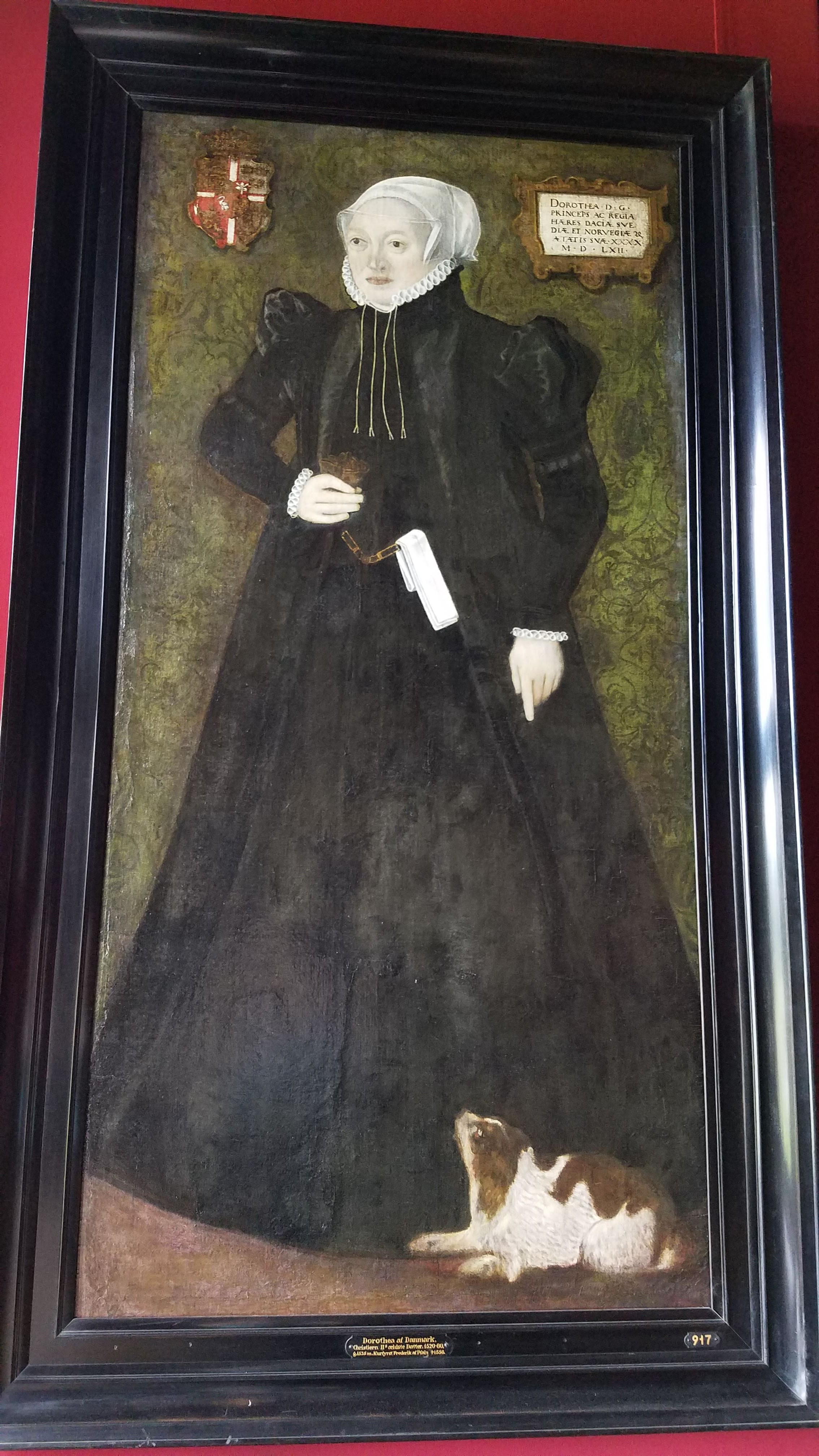
Princess Dorothea (1520-1580), daughter of Christian II
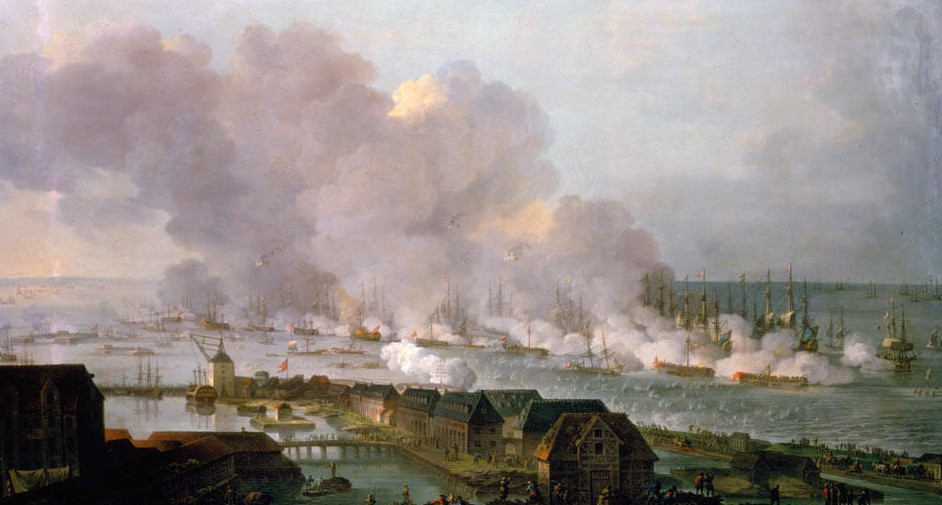
The Battle of Copenhagen, 1801, during the Napoleonic Wars, painted by eyewitness C.A. Lorentzen
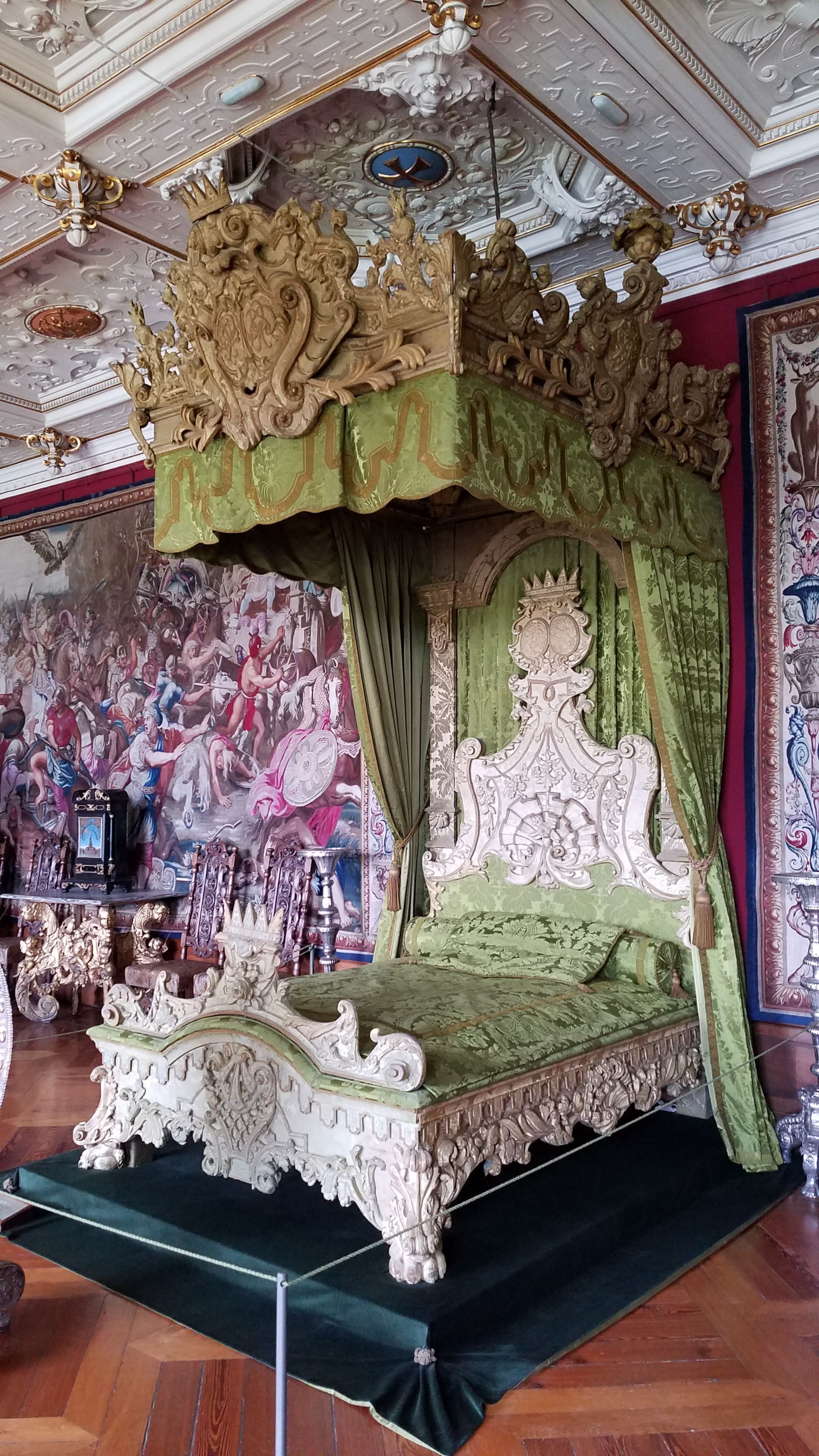
This elaborate bed was made in Paris in 1724 for a newly married Danish count
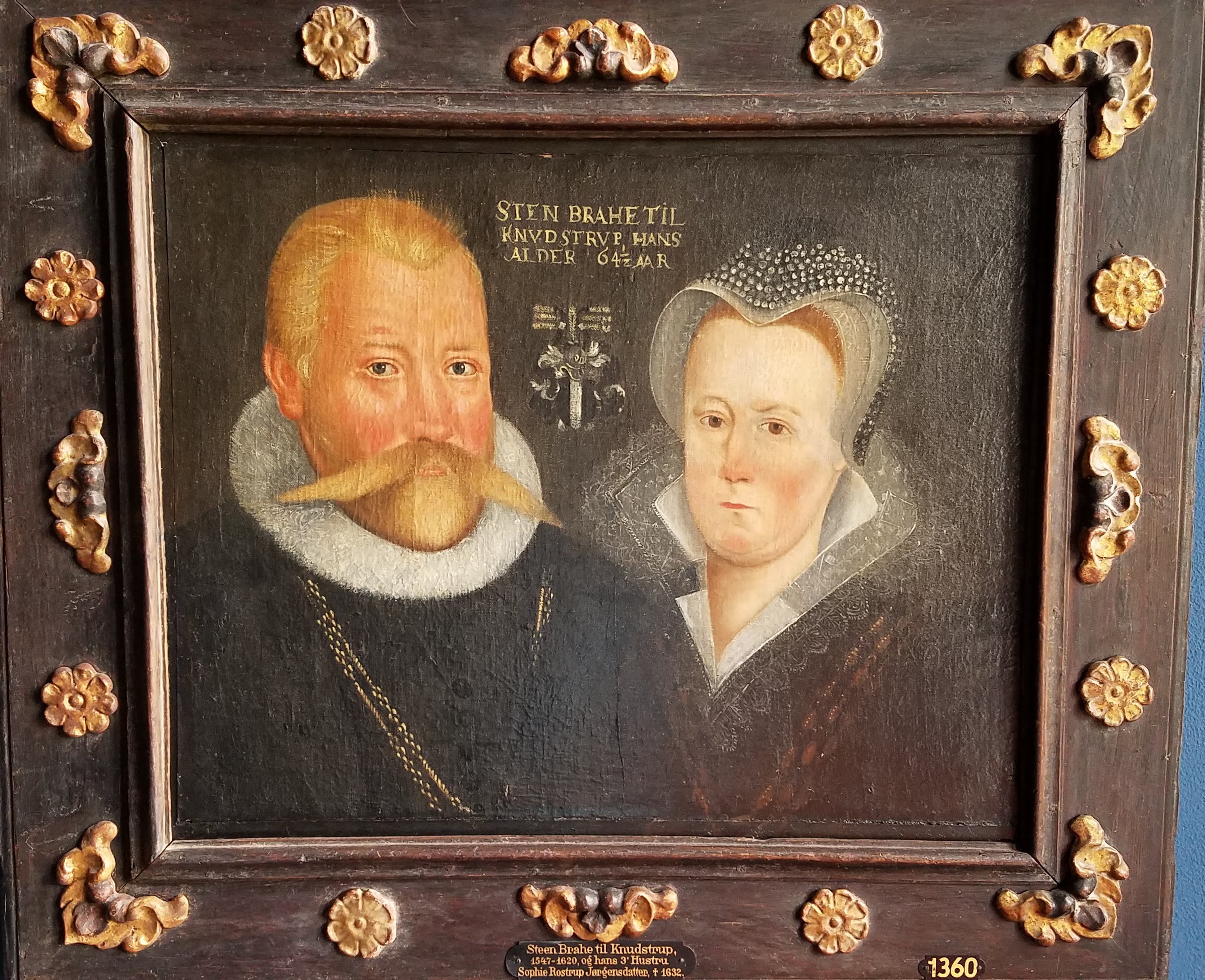
Steen Brahe, brother of astronomer Tycho, with his wife Sophie
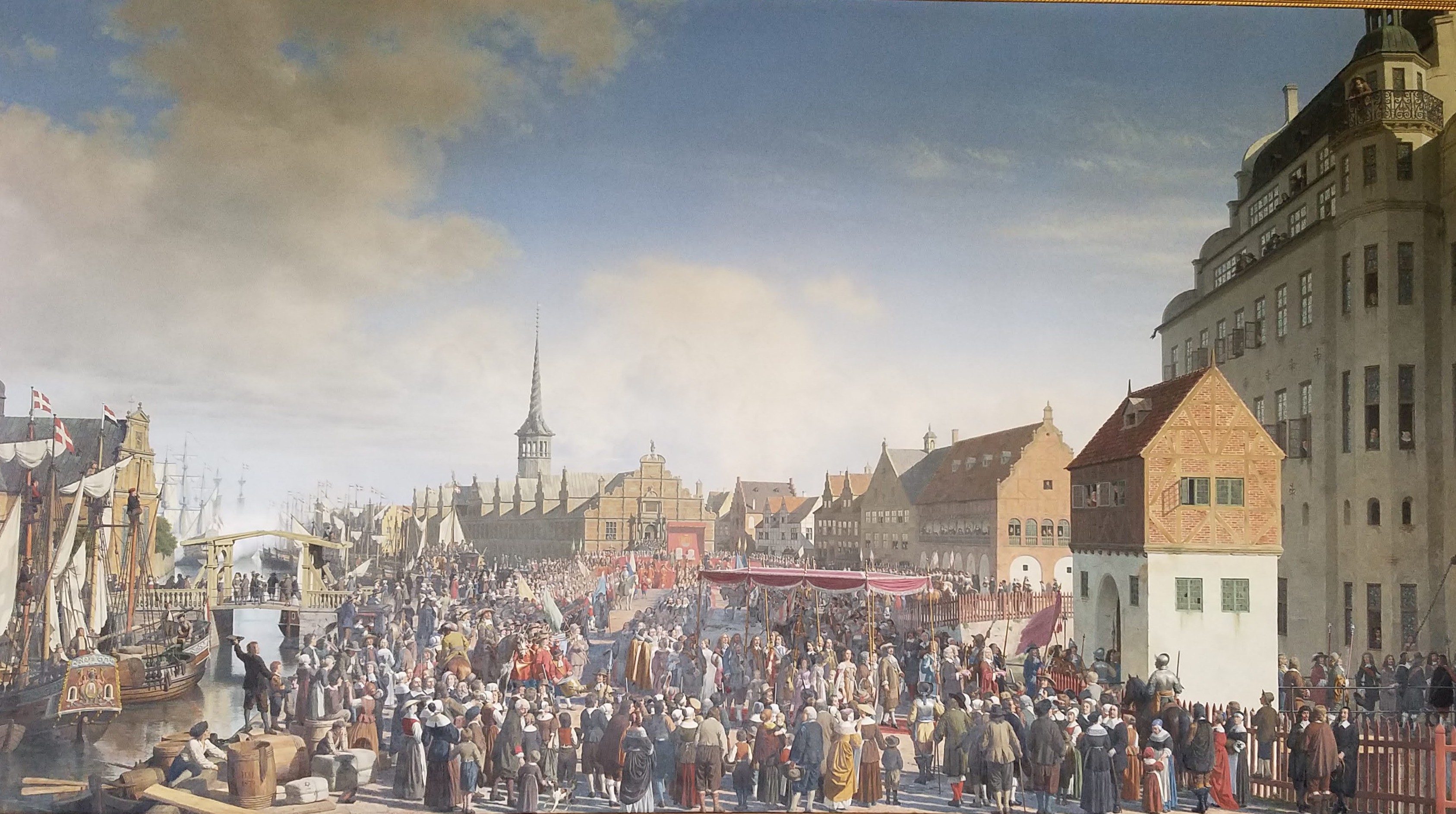
Homage to Frederik III in Copenhagen’s Castle Square, 1660, by Heinrich Hansen. It was painted more than 200 years after the event, but includes historically accurate details
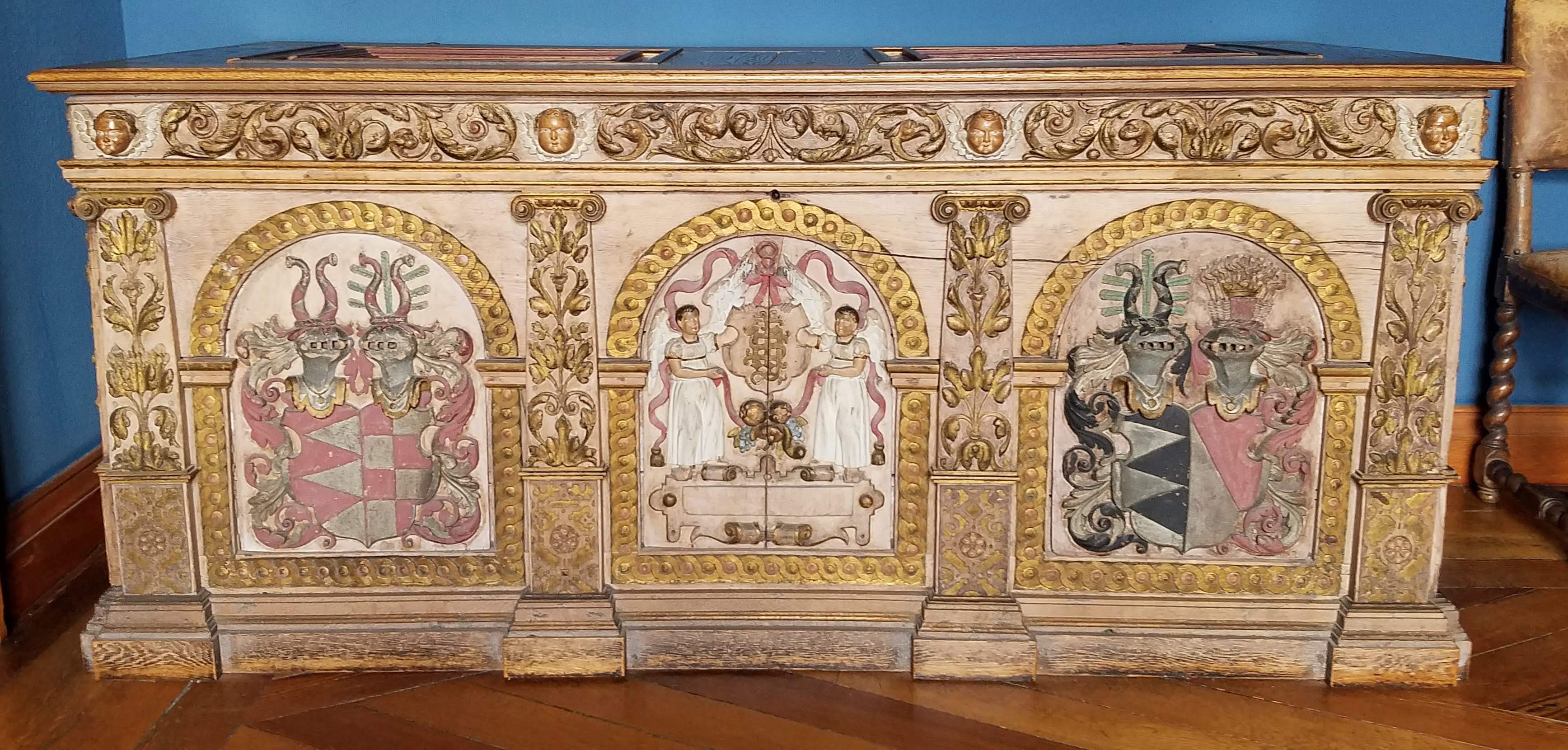
Bureau
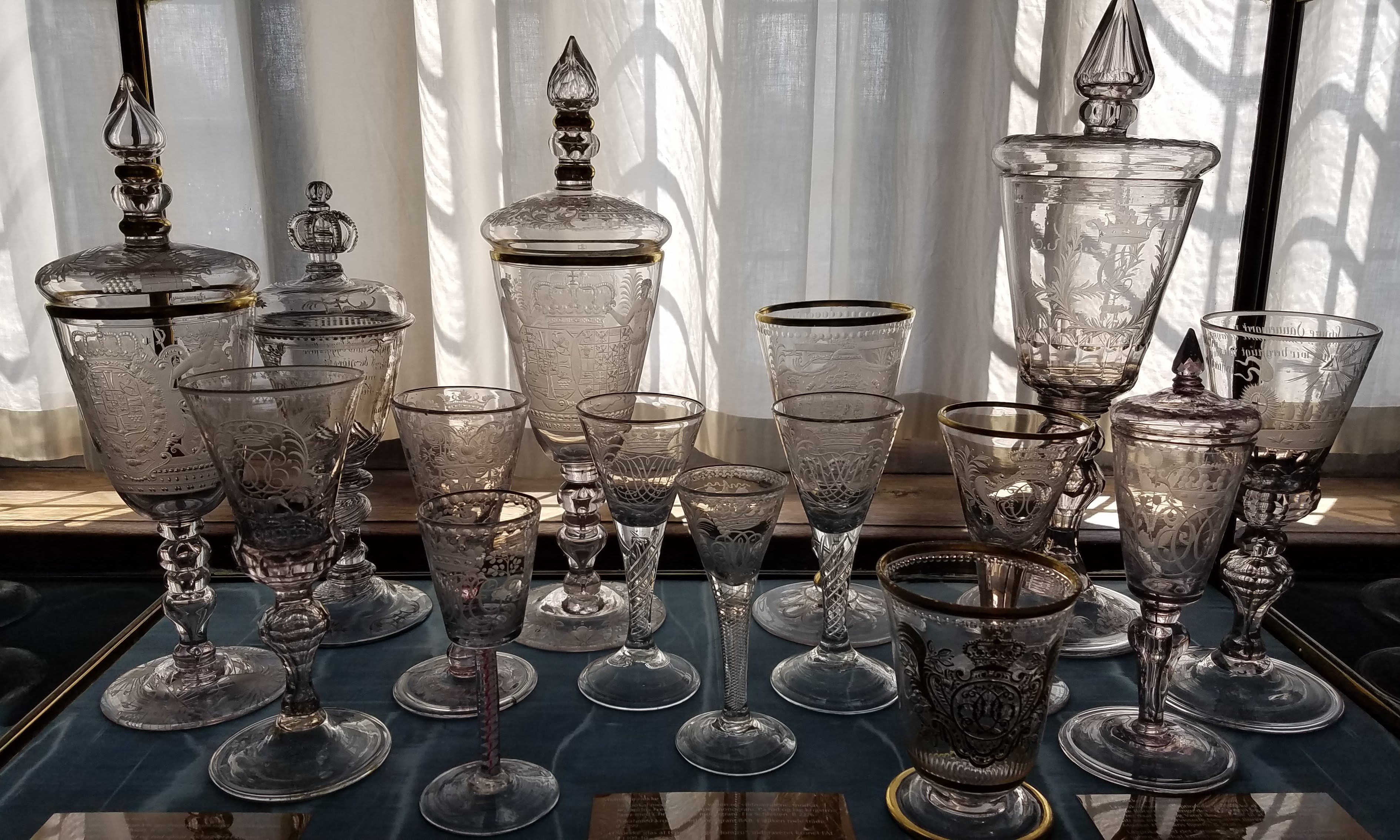
Collection of glassware, c. 1740
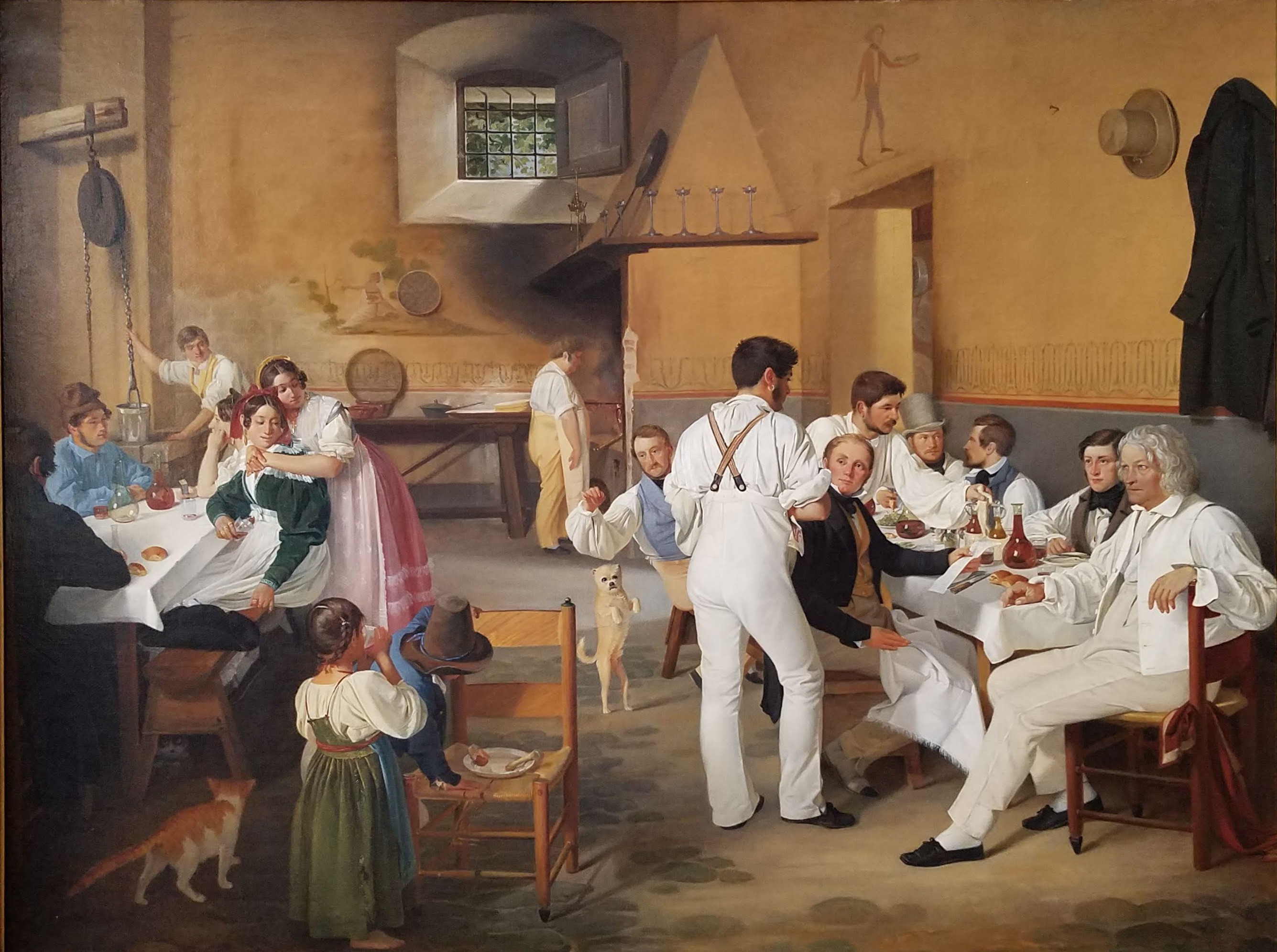
Depiction of Danish artists dining together in Rome by D.C. Blunck, 1836. Sculptor Bertel Thorvaldsen is at the far right
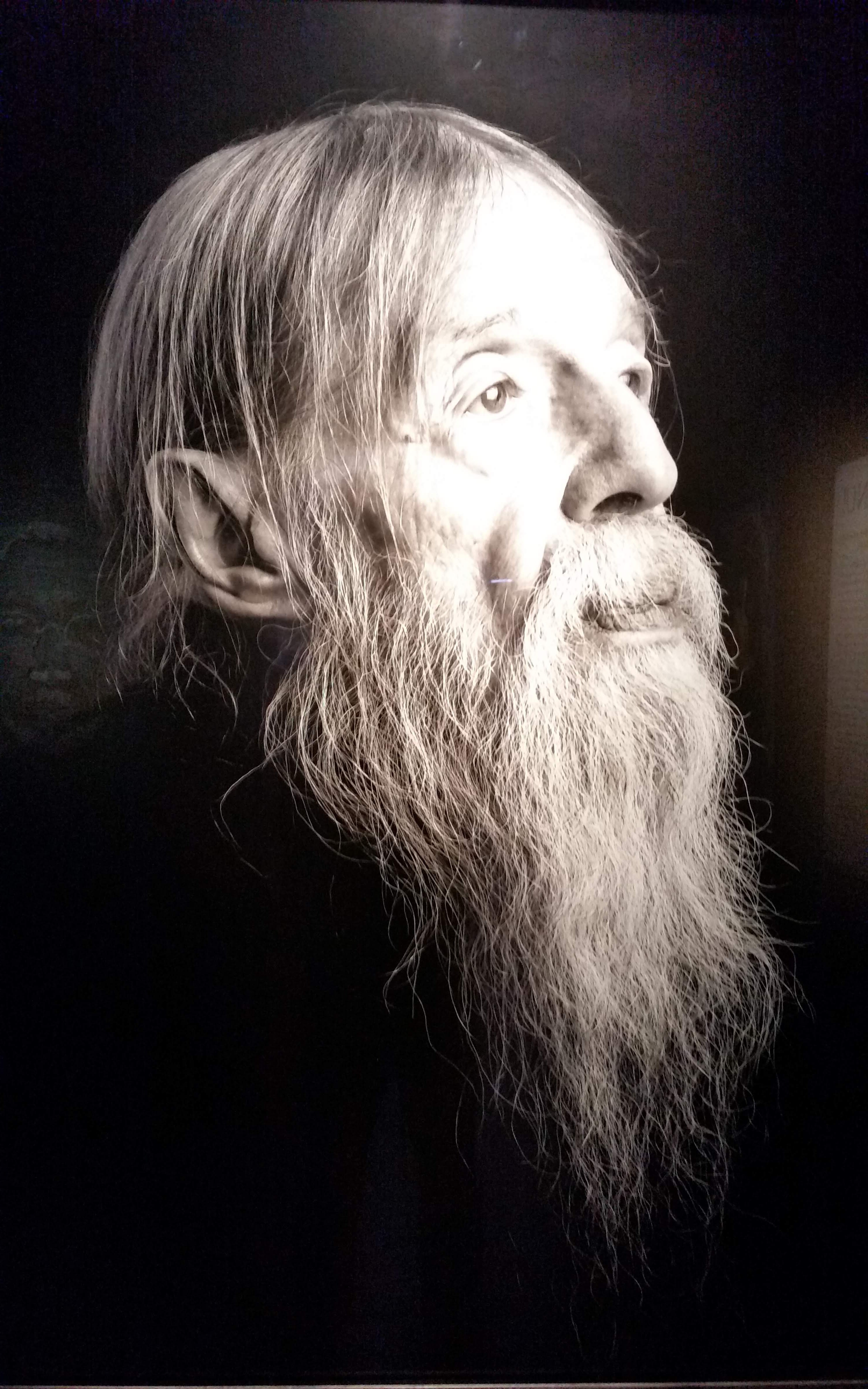
Portrait of Torben Ulrich, taken on his 90th birthday, by Torben Eskerod
A website with Copenhagen travel tips states that the Museum of National History in Frederiksborg Castle “has a collection of more than 10,000 portrait paintings. Not all are on display but after a few rooms it does feel as if most are”—and we wouldn’t disagree. However, we were fascinated by a special exhibit of contemporary paintings and photographs called “Portrait Now!” On display were the winning entries in this biennial competition for Nordic artists, and some of them were absolutely arresting.

First prize: “Lief” by Erik Viklund. The frame is made of plywood taken from the house in which the subject died shortly after this photo was taken

“Unknown girl in a white dress” by Pia Forsberg
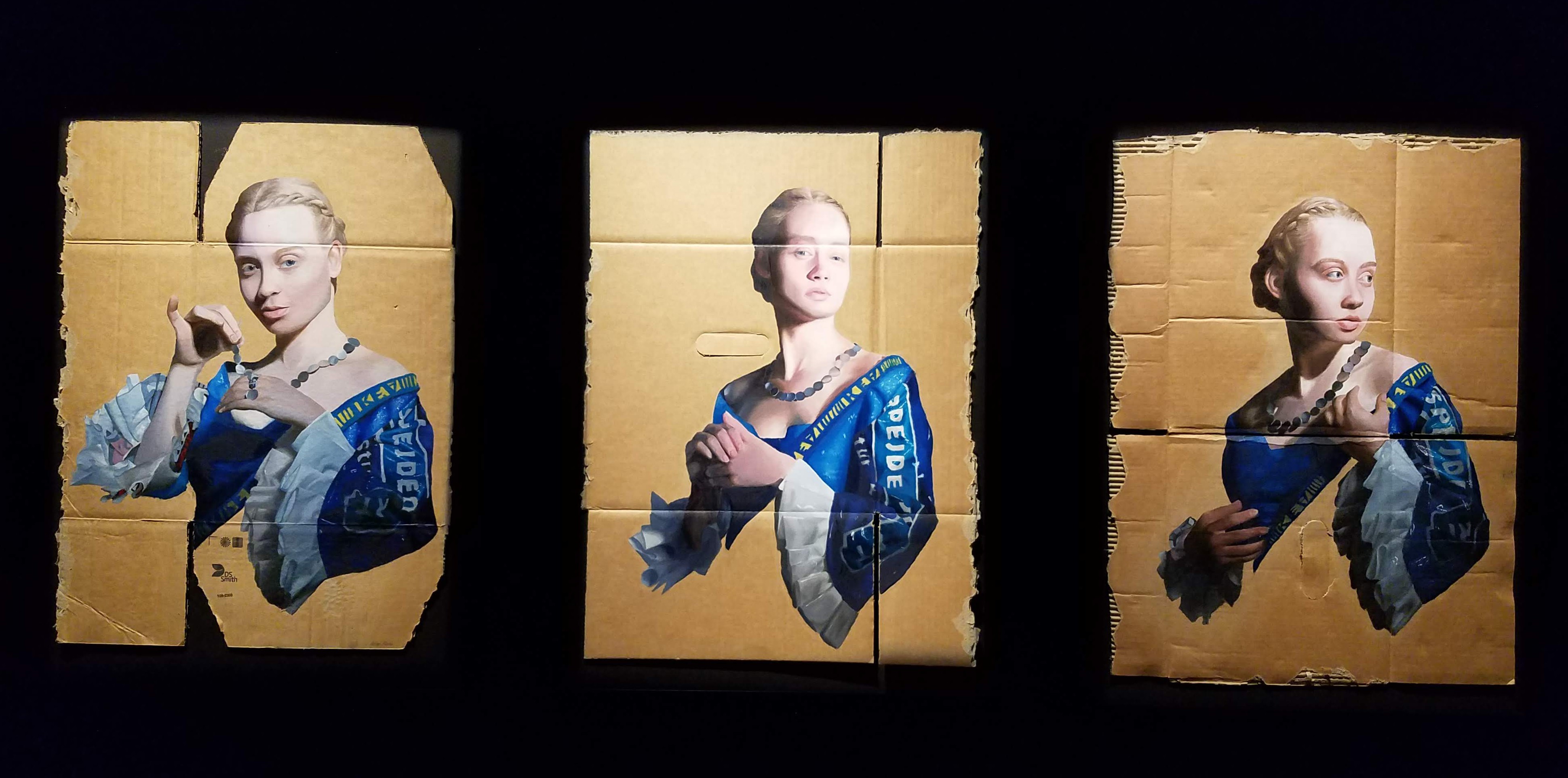
Special prize: “Girl in Consumption” by Astrid Marie Storgaard shows a girl wearing traditionally styled clothing covered with logos of modern consumer goods, painted on pieces of cardboard cartons
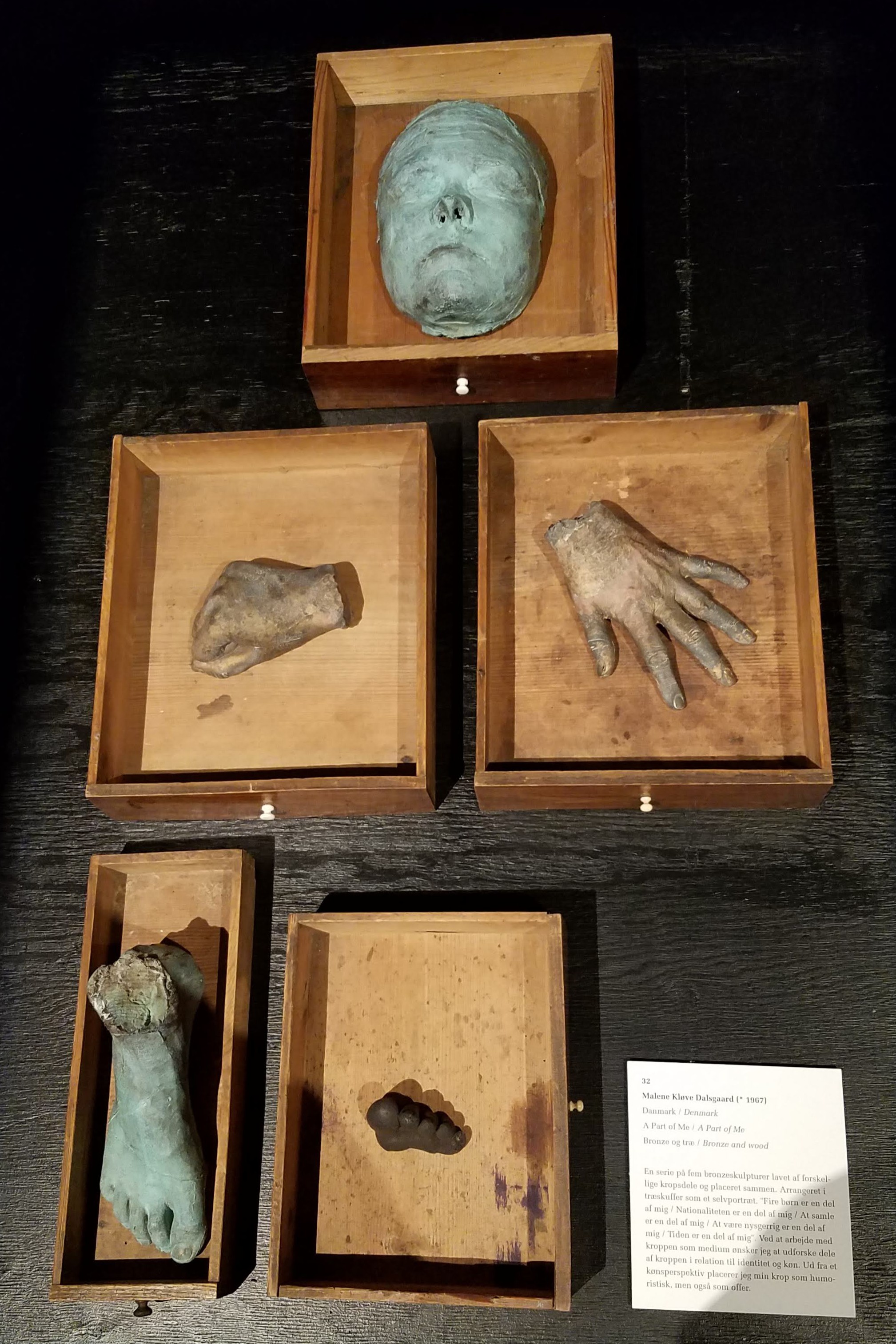
“A Part of Me” by Malene Kløve Dalsgaard
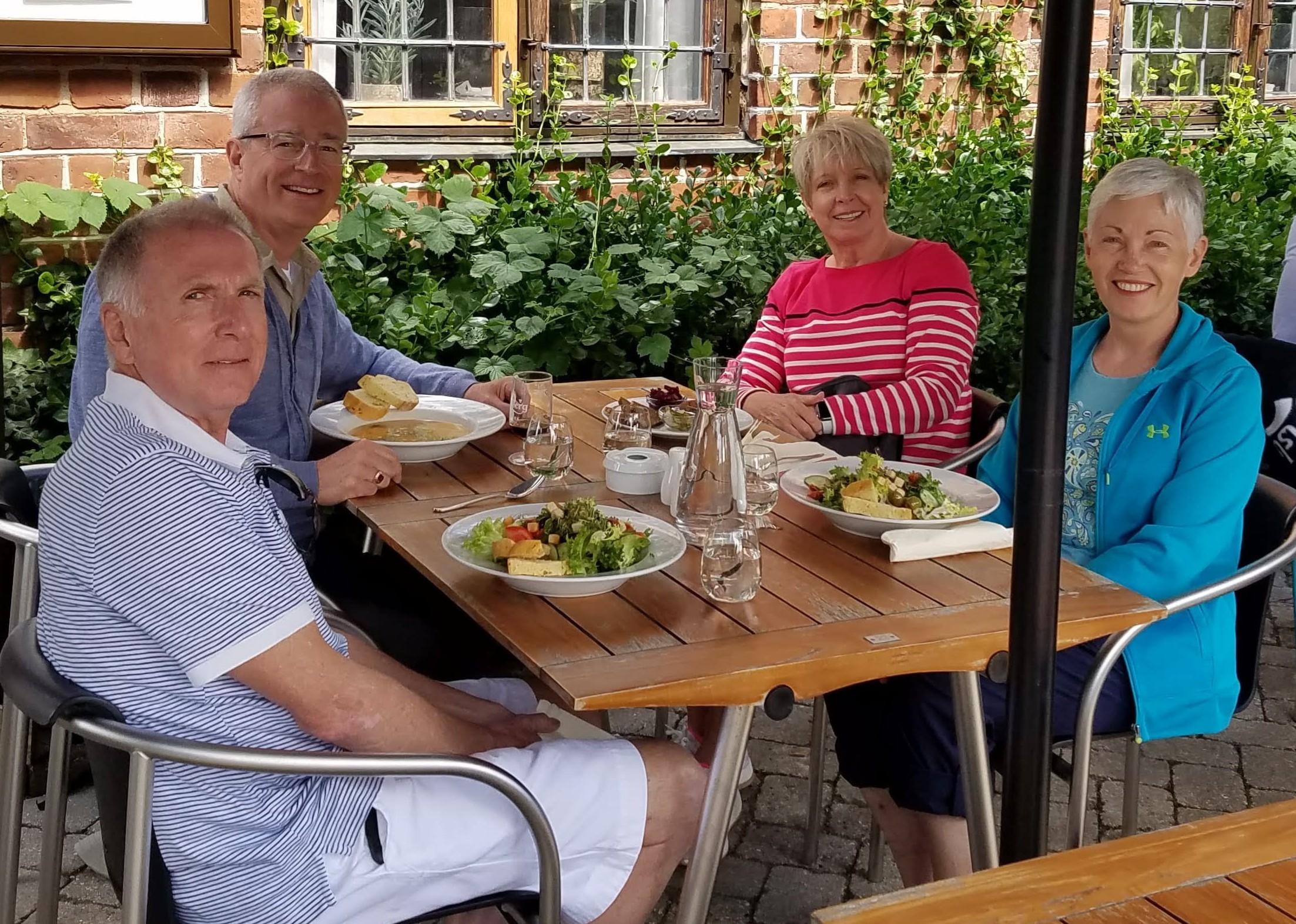
Lunch at Spisestedet Leonora
It was about 1:30 p.m. by the time we walked out of the museum, so we were ready for lunch. Spisestedet (Café) Leonora, which occupies the castle’s former stables, had a table available outside, so we enjoyed the pleasant weather along with our salads, curry-coconut soup, and some little sandwiches we had brought from the hotel’s breakfast buffet. Most of the other patrons also were enjoying beer from Carlsberg, the brewing company that remains the museum’s main sponsor.
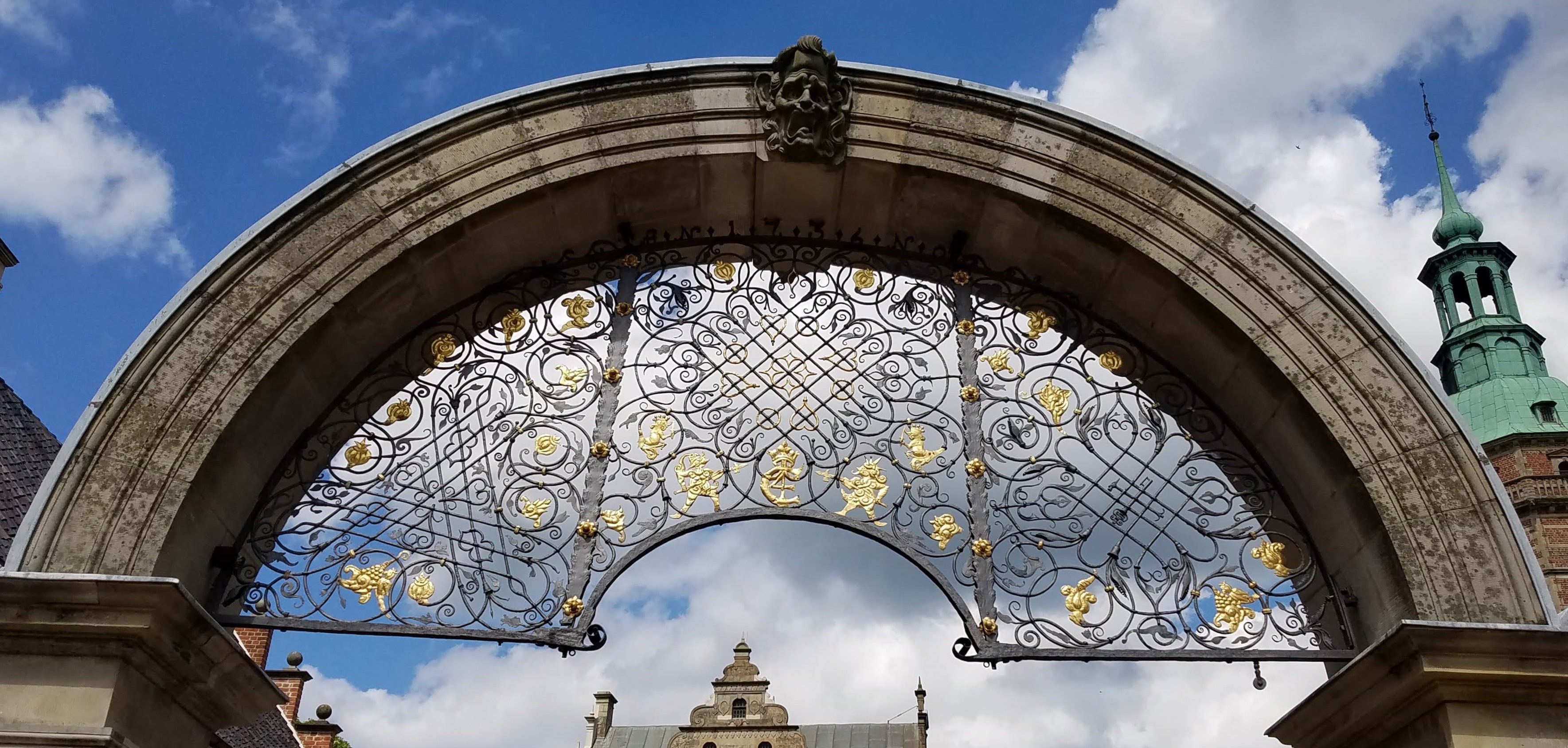
Filigree gate over a side entrance to the castle courtyard
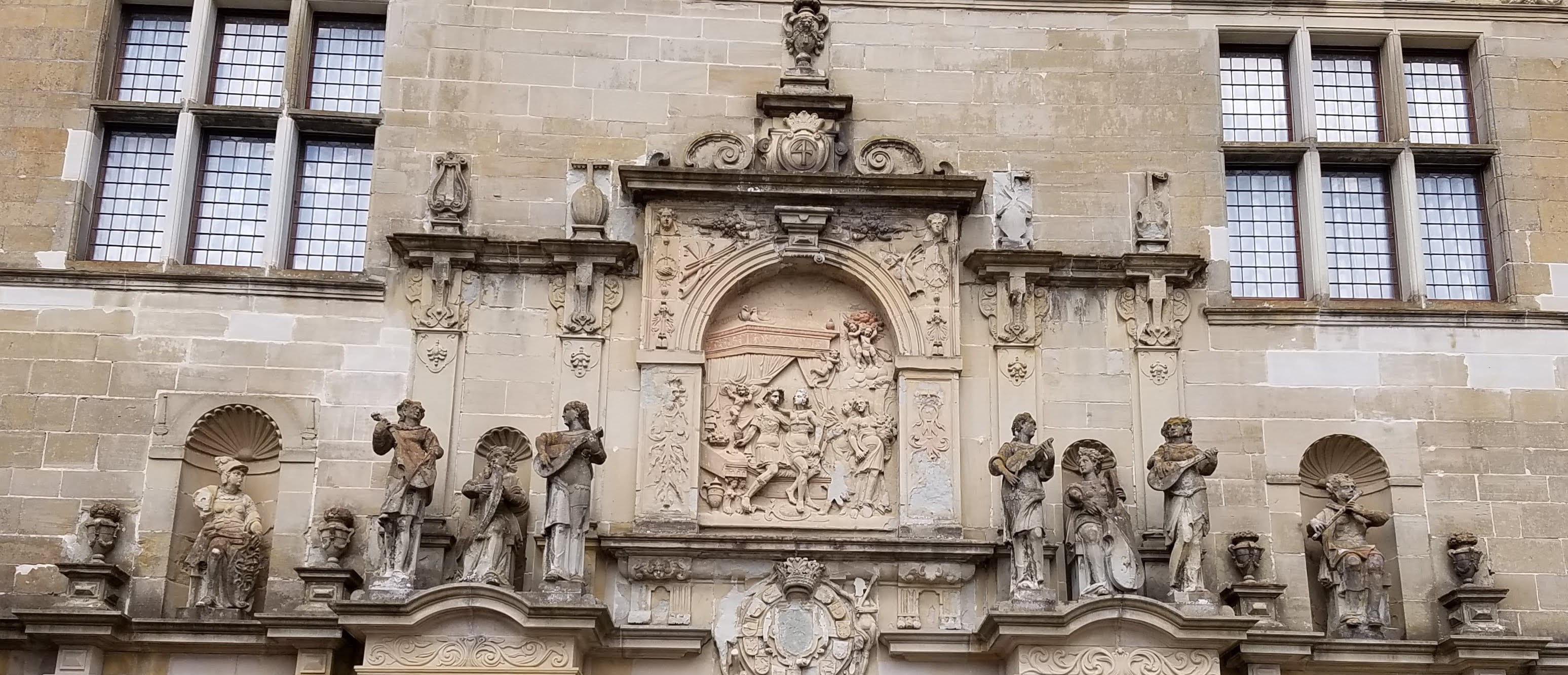
In this frieze over the entrance to the 17th-century residential wing, court musicians and cherubic angels celebrate the royal union that produced Christian IV
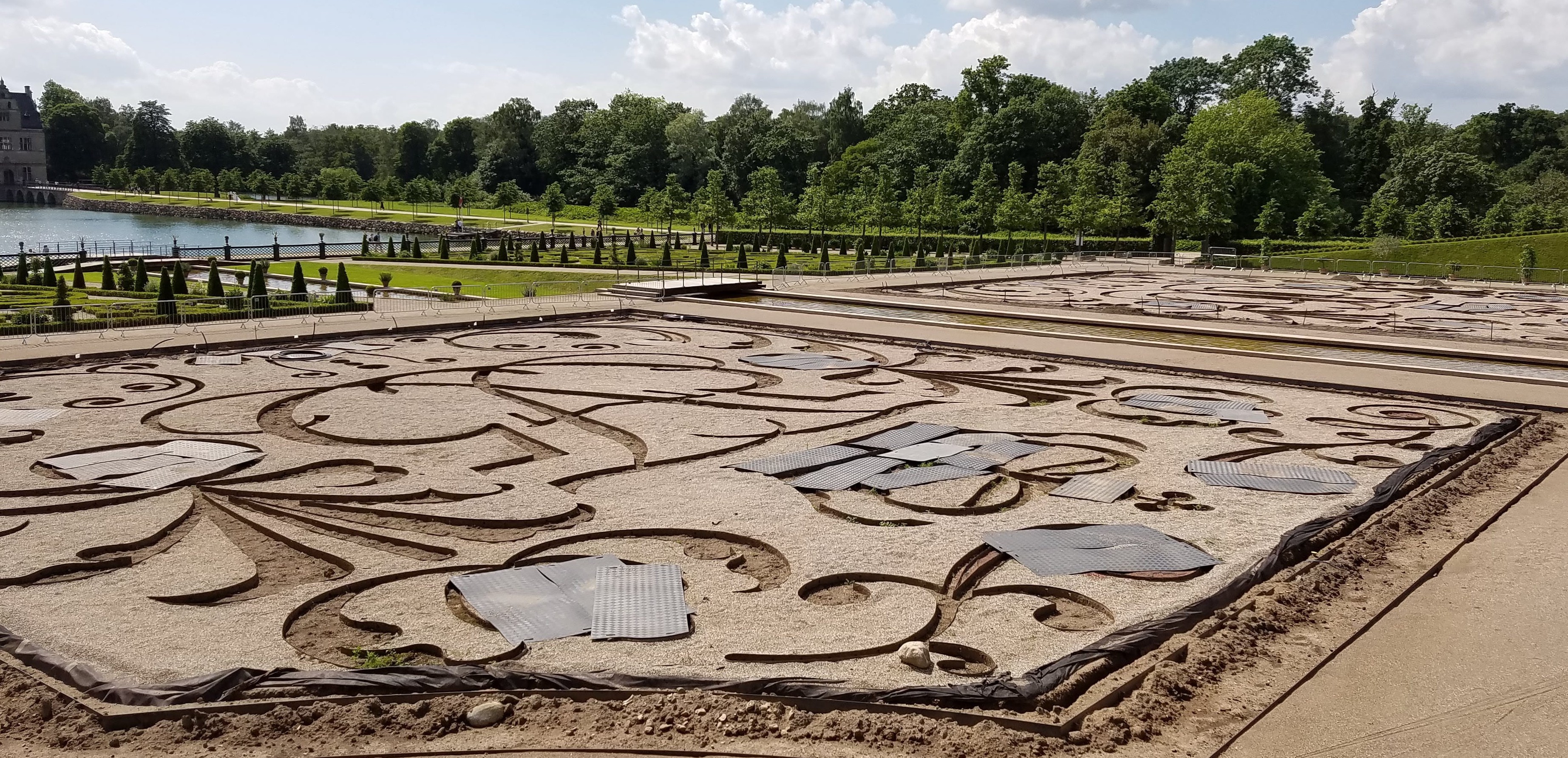
Formal garden under development
After lunch, we walked toward the lake and through the well-manicured gardens behind the castle. Frederiksborg was the first castle in Denmark to be built inland rather than on the coast, and the first to serve not as a fortress but as a leisure residence for the reigning monarch—in this case, Frederik II. During the first half of the sixteenth century, Frederik’s son and successor, Christian IV, turned his birthplace into a luxurious Renaissance palace. Frederiksborg has been called “Denmark’s Versailles,” but perhaps Versailles should be called “France’s Frederiksborg” because work didn’t begin on Louis XIV’s palace until a decade after Christian IV’s was completed.
In Frederiksborg’s formal gardens we could view both the finished work of the castle’s landscape designers and sections still under development. It was interesting to see exactly how gardeners coax ordinary boxwoods to grow into such intricate patterns.

If you look closely, you can see a bride and her photographer using the castle and gardens as the backdrop for formal bridal portraits
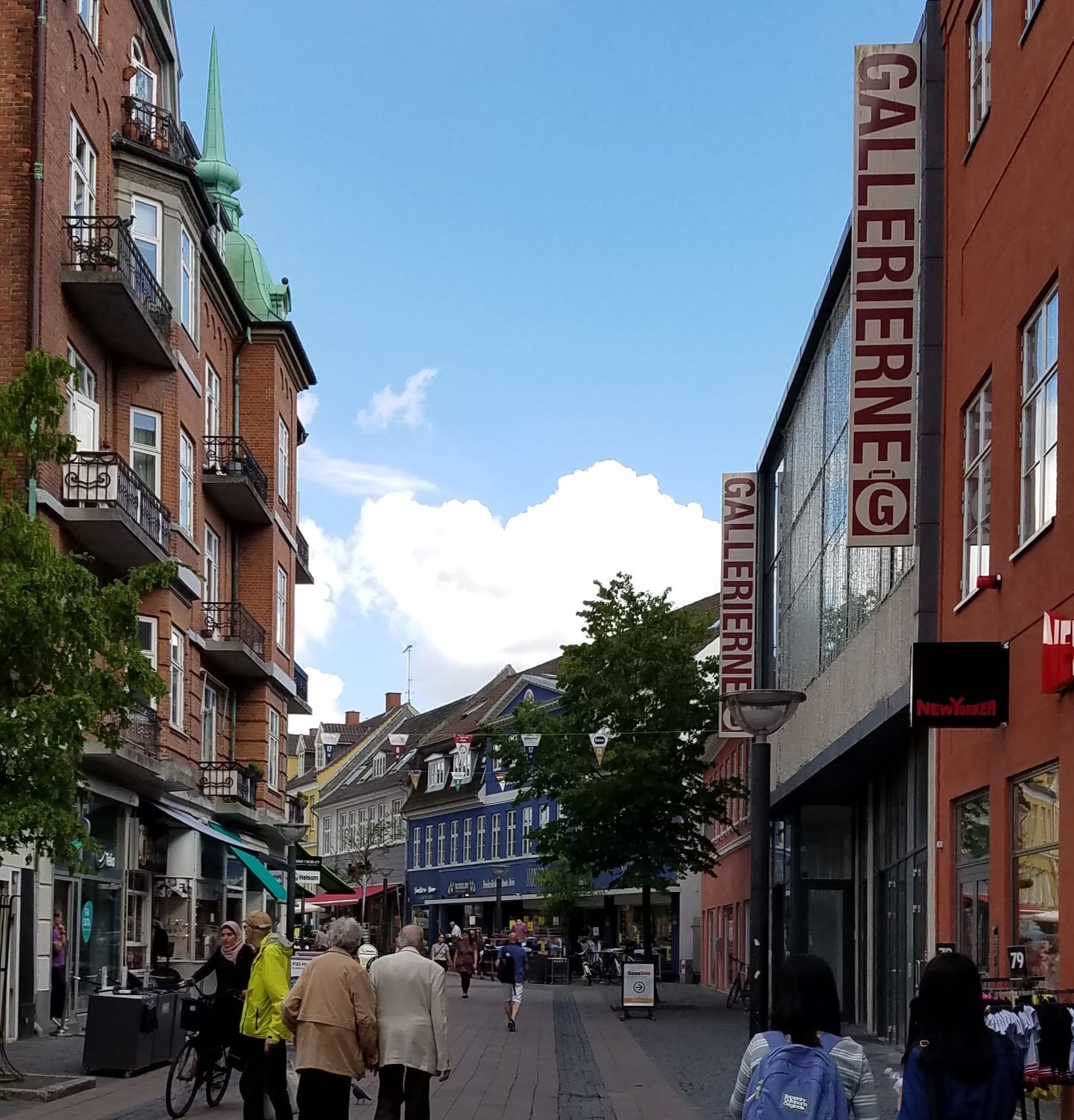
Hillerød’s pedestrian shopping district
When we heard the bells in the castle belfry chime 3:00 (and then play a lovely rendition of the Crusaders’ Hymn), we knew it was time to start heading toward the train station. Nancy and Pam had hoped to do some souvenir shopping at what appeared to be a nice gift shop that our bus had passed on our way to the castle this morning, but Michael didn’t get the memo and led us back toward the station by a more direct pedestrian route. We walked through the center of Hillerød where there were plenty of shops, but nothing really catering to the tourist trade. We browsed sidewalk displays of clothing, shoes, and hats, and then were happy to encounter a gelateria.

GiovannIs
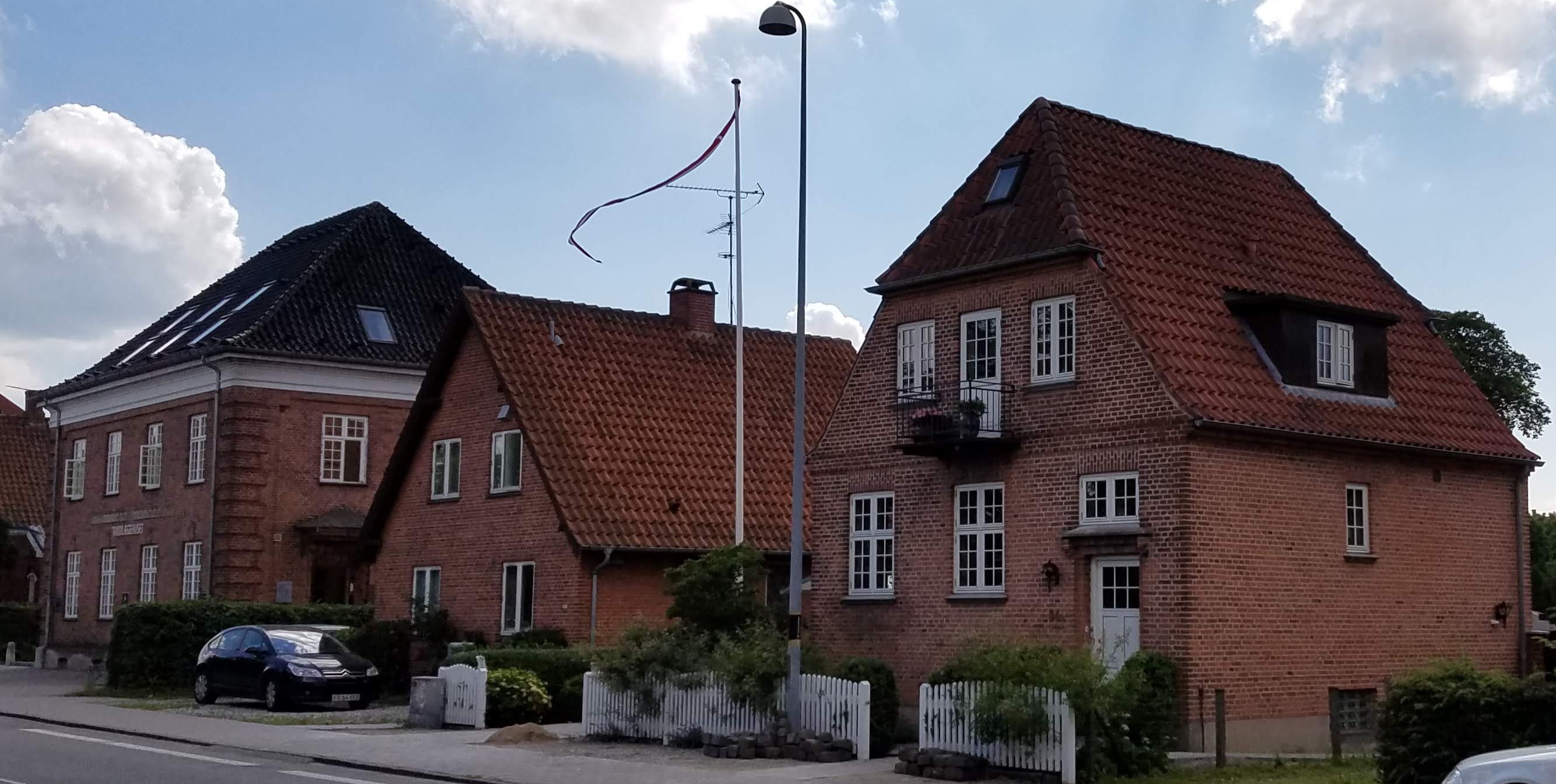
Typical townhouses in Hillerød
Even though we didn’t have a chance to sample anything from a local competitor, we feel confident stating that we found the best gelato in Hillerød because what we tasted at GiovannIs was even better than what we had consumed at Siciliansk Is in Copenhagen. (The pistachio was unparalleled.)
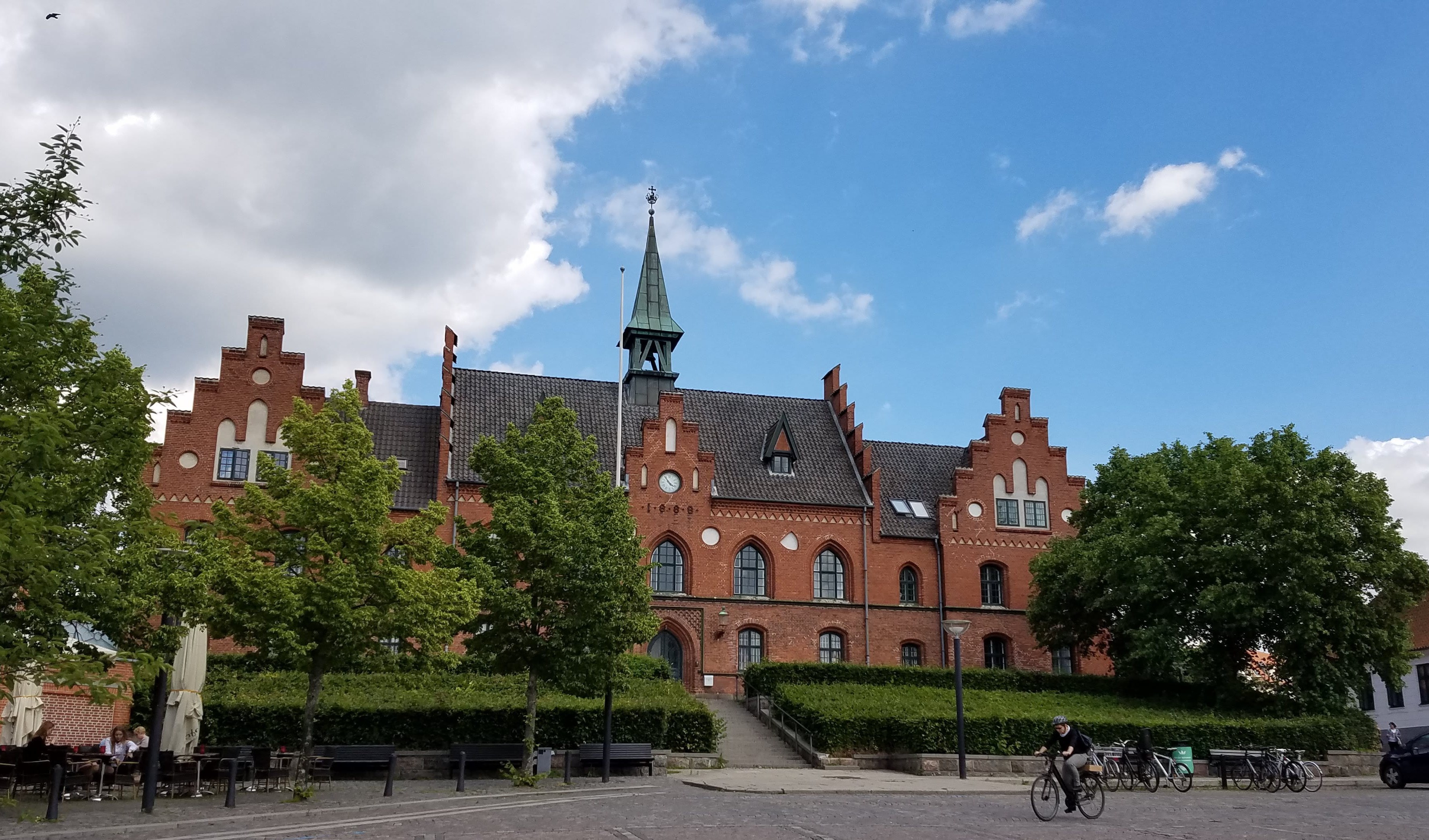
We thought this attractive building on a large square must be Hillerød’s town hall, but it’s actually part of the regional police and prison compound
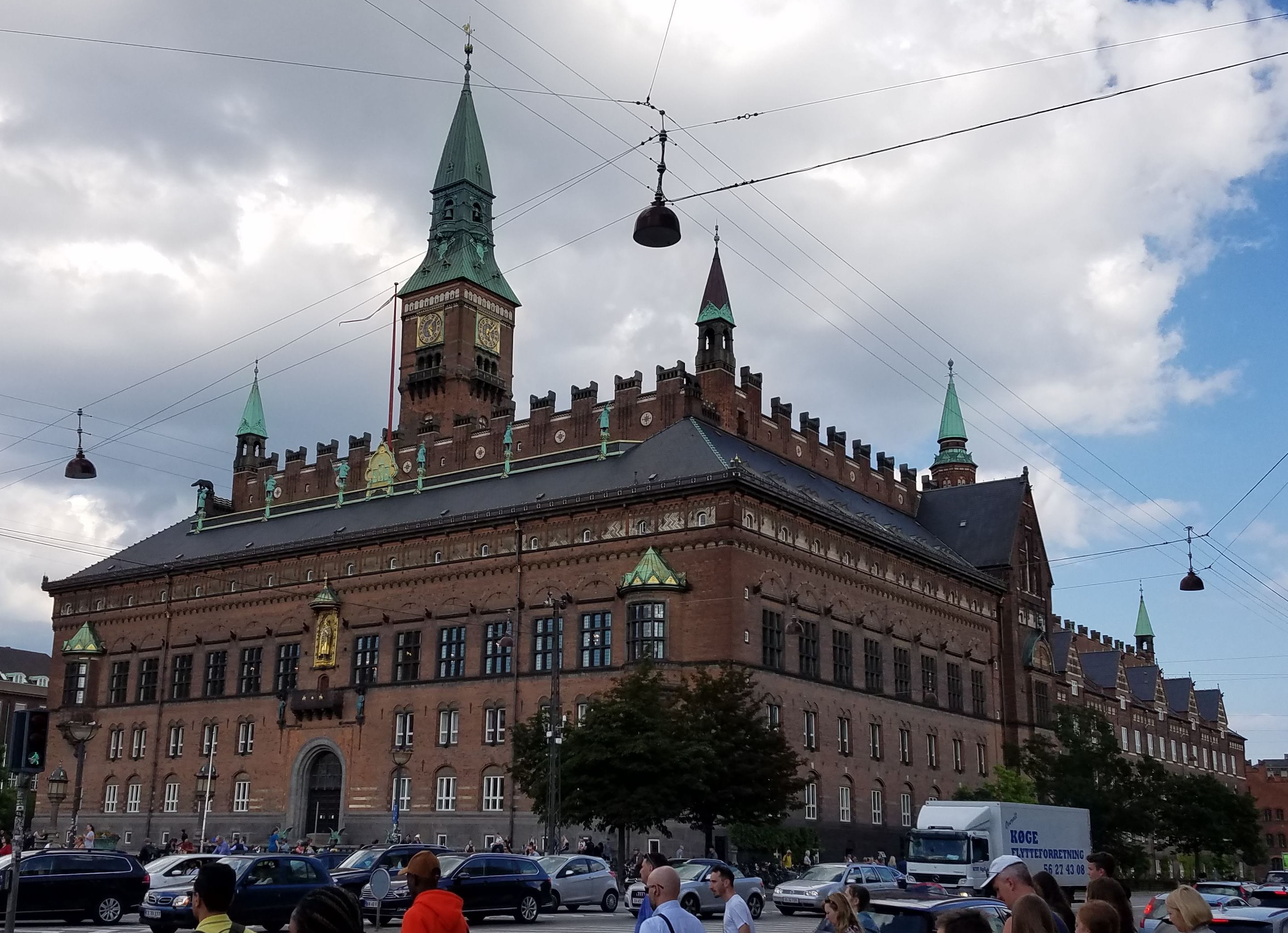
Copenhagen City Hall
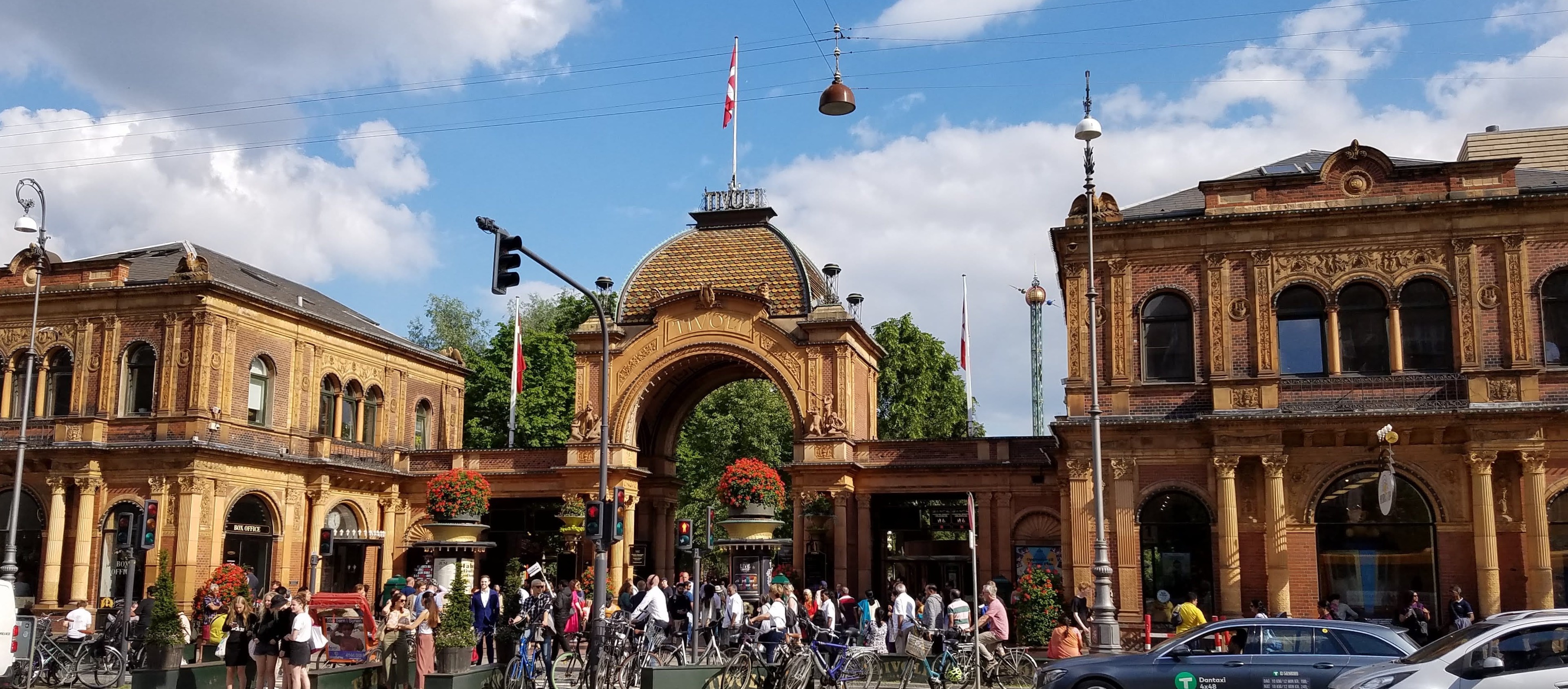
We decided to pass on visiting Tivoli, a popular amusement park in central Copenhagen
The train brought us back to the Nørreport Station by about 5:30. Eric went back to the hotel, but the rest of us took another hour to scour Copenhagen’s shopping district to make sure we would return to the States with gifts for each of our grandchildren.

The spread at Restaurant Flammen Nyropsgade
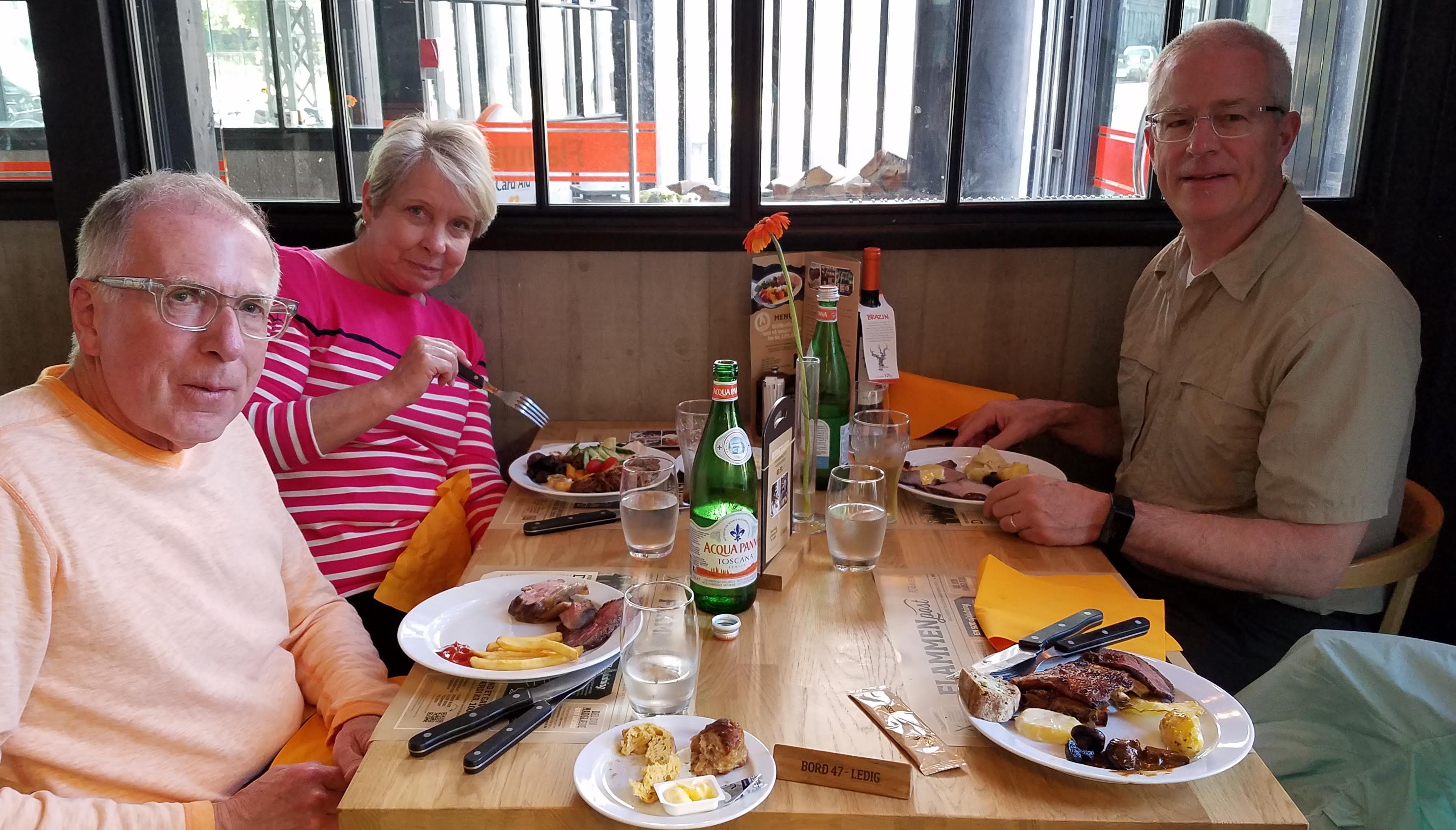
Eric, Pam, and Michael at Restaurant Flammen
After dropping our purchases at the hotel and rousing Eric from his nap, we walked a few blocks down the Søgade and around a corner to Restaurant Flammen Nyropsgade, an all-you-can-eat barbecue buffet that might be described as the Danish version of Golden Corral—except that the quality of the food was somewhat better. (And sort of Danish. Like there was herring in cream sauce and grilled salmon in addition to the beef fillets and pork ribs.)
We skipped the soft-swirl sundaes and went back to Siciliansk Is for dessert, even though we had decided that Hillerød’s GiovannIs offered a superior product. Tonight, Nancy’s trio of flavors included mandarin, blood orange, and sea buckthorn (an orange berry whose essential oil has a sour, astringent taste, similar to cranberries). The subtle differences among the tart, citrusy flavors made for an interesting combination.

Blooms and bikes outside an apartment building on Søgade

The path along the shore of The Lakes
Pam and Eric had persuaded us to take a taxi from the restaurant to the gelateria and then called another to pick them up, but the two of us decided to walk back to the hotel so we could enjoy one more evening strolling along the shore of The Lakes before we had to begin packing for tomorrow’s flight home.
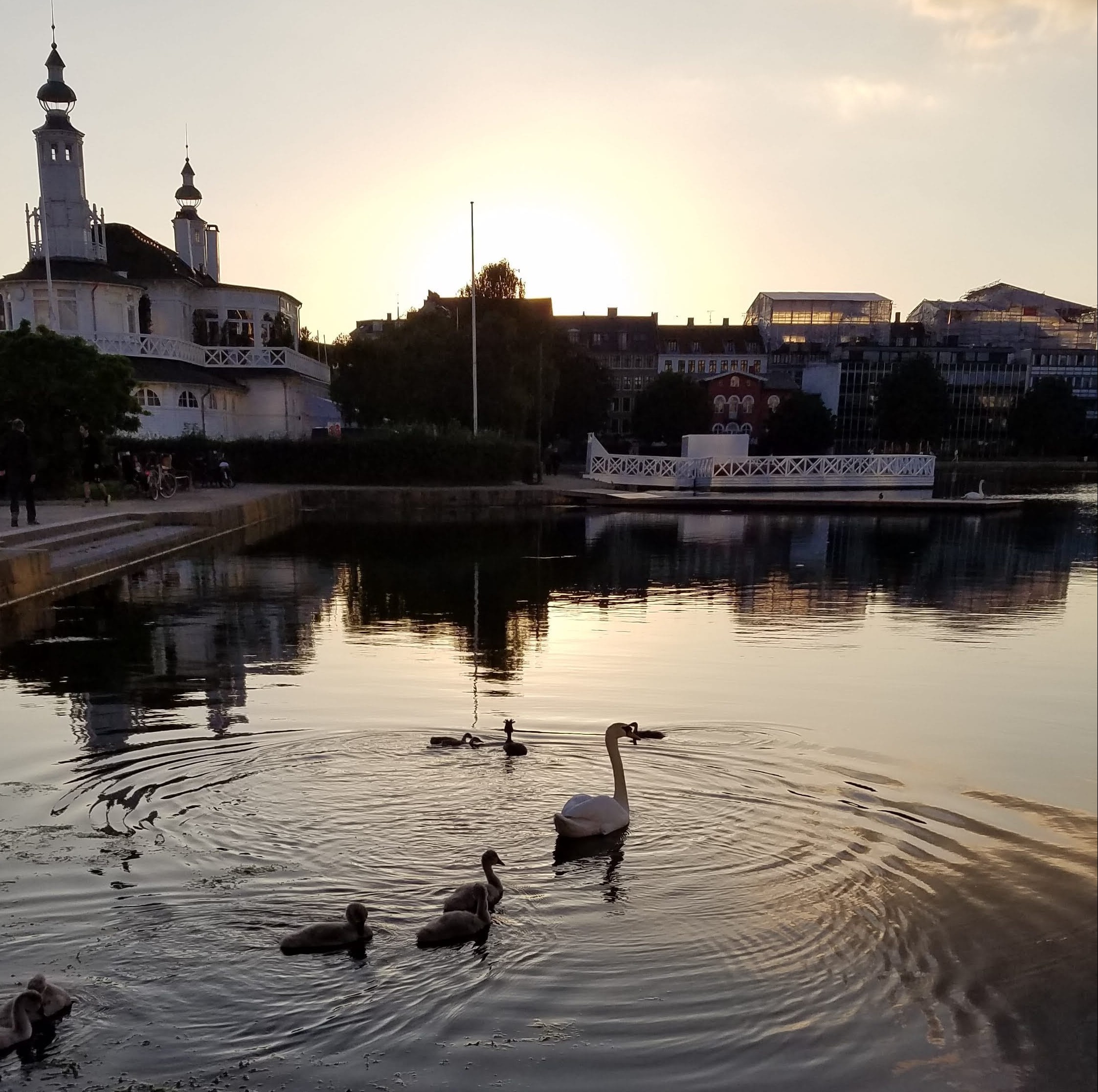
Swan and cygnets near the Pavilion on Peblinge Sø
Leave A Comment